
This article provides a step-by-step guide to keyword research, which is essential to any successful SEO campaign. It begins with an initial site audit to identify the keywords that a site currently ranks for, then refining the keyword plan by assessing the optimization cost for each keyword and drilling down into long-tail keywords. Regular reviews and seasonal keyword research should also be conducted to ensure the keyword strategy is up-to-date.
Introduction
Overview of the keyword research process
Initial keyword research efforts
Initial Site Audit
Establishing a starting point
Keyword Research: A Step-by-Step Guide
Keyword research is an essential part of any successful SEO campaign. It is the process of identifying and analyzing the words and phrases people use to find your products and services. By understanding what people are searching for, you can develop a comprehensive keyword strategy that will help to drive more qualified traffic to your website. In this article, we will discuss the different phases of keyword research and how to implement them effectively.
I. Introduction
A. Overview of Keyword Research Process
The keyword research process begins with an initial site audit. This audit will provide a starting point for the big-picture SEO project and help to identify the keywords that a site currently ranks for. From here, the keyword research process can be broken down into four distinct phases: initial site audit, refining keyword plan, regular reviews, and seasonal keyword research.
B. Initial Keyword Research Efforts
The initial keyword research efforts should focus on identifying the words and phrases people use to search for your products and services. This can be done using keyword research tools such as Google Keyword Planner, Moz Keyword Explorer, and Ahrefs Keywords Explorer. These tools can provide valuable insights into keywords' search volume and competition levels.
II. Initial Site Audit
A. Establishing a Starting Point
The initial site audit is the first step in the keyword research process. This audit will provide a starting point for the big-picture SEO project and help to identify the keywords that a site currently ranks for. This can be done using a combination of tools such as Google Search Console, Moz Keyword Explorer, and Ahrefs Keywords Explorer.
B. Requirements of First Estimate
Once the initial site audit is complete, the next step is to determine the requirements of the first estimate. This will include a basic assessment of the keywords that a site currently ranks for and a list of keywords that would likely benefit the company. It is important to note that the keyword research process should not be limited to the keywords that a site currently ranks for. Instead, keyword research should focus on finding the best keywords to help drive more qualified traffic to the website.
III. Refining Keyword Plan
A. Assessing the Cost of Optimization
Once the initial keyword research efforts are complete, refining the keyword plan is next. This involves assessing the cost of optimization for each keyword. This can be done using a combination of tools such as Google Adwords and Moz Keyword Explorer. These tools will provide insights into each keyword's cost per click and the competition level.
B. Drilling Down into Long-Tail Keywords
In addition to assessing the optimization cost for each keyword, it is also important to drill down into the long-tail keywords. Long-tail keywords are more specific phrases that are less competitive and often have a lower cost per click. As a result, these keywords can be more effective at driving qualified traffic to the website.
IV. Regular Reviews
A. Updating Keyword Plan with New Data
Once the keyword plan has been refined, it is essential regularly review and update it with new data. This can be done using a combination of tools such as Google Adwords and Moz Keyword Explorer. These tools will provide insights into each keyword's cost per click and the competition level.
V. Seasonal Keyword Research
A. Benefits for Nearly Every Site
Seasonal keyword research is an essential part of any SEO campaign. This type of keyword research can provide valuable insights into the words and phrases people use to search for products and services during different times of the year. This keyword research can benefit nearly every website, from e-commerce stores to local businesses.
B. Scheduling Separate from Regular Keyword Reviews
It is important to note that seasonal keyword research should be scheduled separately from regular keyword reviews. This is because seasonal keywords may not be relevant year-round, and keeping the keyword plan up-to-date with the latest data is essential.
Conclusion: In conclusion, keyword research is essential to any successful SEO campaign. It is the process of identifying and analyzing the words and phrases people use to find your products and services. By understanding what people are searching for, you can develop a comprehensive keyword strategy that will help to drive more qualified traffic to your website.
The keyword research process can be divided into four phases: initial site audit, refining keyword plan, regular reviews, and seasonal keyword research. By understanding and implementing each of these phases, you can ensure that your keyword research efforts are successful.
The success of SEO keyword research lies in the exploration of its phases.
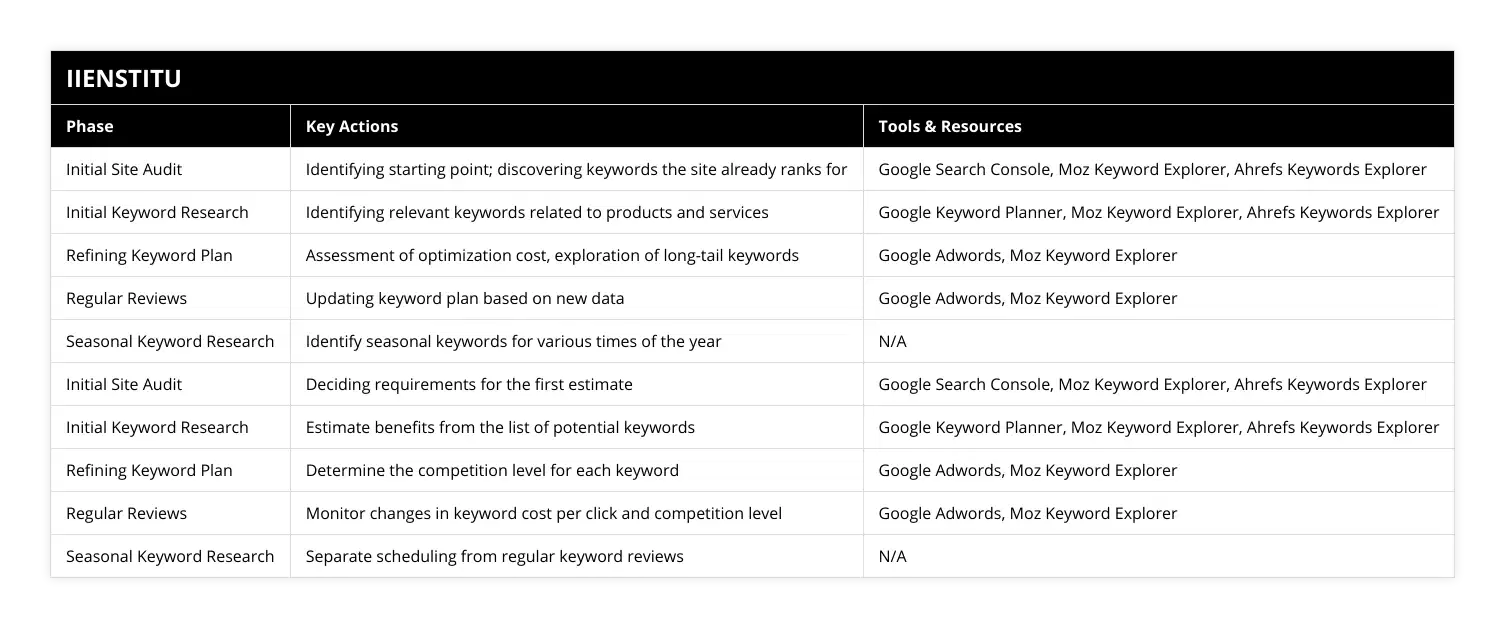
Frequently Asked Questions
What is the process of keyword research in SEO?
Keyword research is essential in search engine optimization (SEO) and is vital for optimizing website content to improve its ranking in search engine results pages (SERPs). Keyword research involves discovering the terms and phrases that potential customers use when searching for a product or service online. It requires an understanding of the target audience, the intent behind their search queries, and the most relevant keywords that should be included in the website content.
The first step in keyword research is to identify the target audience. This includes understanding the target audience's demographics, their language, and the topics they are interested in. This helps to identify the issues that need to be targeted in content.
The second step is to determine the intent of the audience. This includes understanding the purpose behind their search and the type of content they are looking for. This can be done by analyzing search terms and exploring related topics.
The third step is to identify the most relevant keywords that should be included in the content. This can be done by analyzing search engine results pages, examining competitors' websites, and using keyword research tools. These tools can help identify the most searched words and phrases and related terms that can be used in the content.
The fourth step is to create optimized content for the identified keywords. This includes ensuring that the content is relevant and written in a way optimized for search engine algorithms. It also involves using the keywords in the title, meta description, and headings.
Finally, the content should be monitored and analyzed to determine its success in terms of rankings and engagement. This can be done by tracking the search engine position of the content and measuring the traffic it receives. This helps to identify areas for improvement and the effectiveness of the keyword research process.
In conclusion, keyword research is an essential step in SEO and is necessary for optimizing website content to improve its ranking in SERPs. It involves understanding the target audience, the intent behind their search queries, and the most relevant keywords that should be included in the content. Proper keyword research can help improve a website's visibility and increase its chances of being found by potential customers.
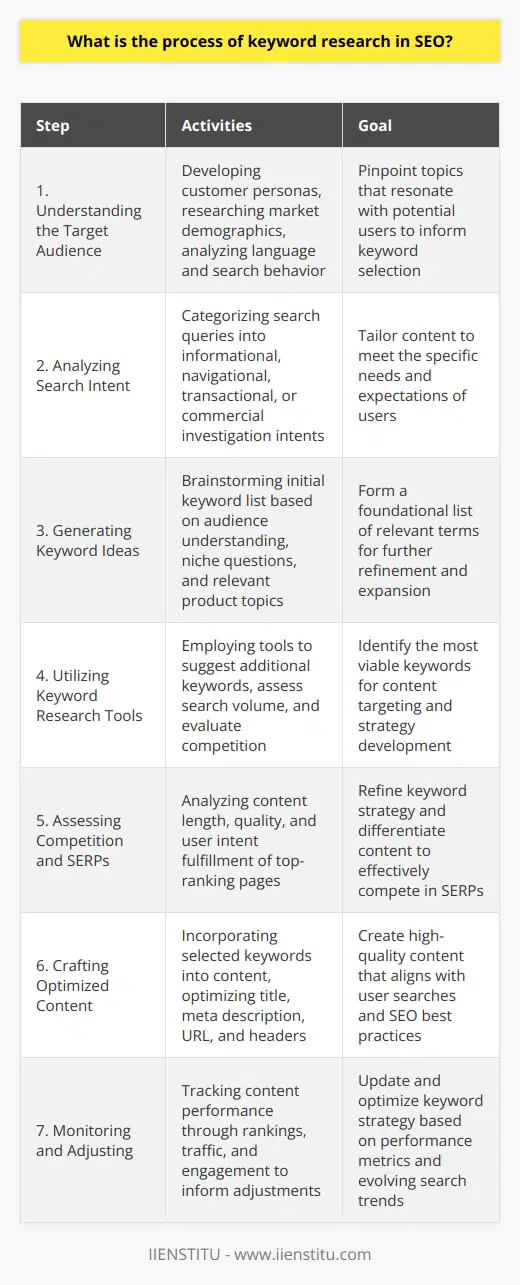
How can I refine my keyword plan to optimize cost?
Keyword planning is essential to any successful search engine optimization (SEO) campaign. It is vital to ensure that the keywords used are relevant to the website's content and optimally targeted to the target audience. Refining a keyword plan is critical in optimizing costs and maximizing the effectiveness of SEO campaigns.
The first step in refining a keyword plan is identifying the most appropriate keywords. This process involves researching the target audience and understanding their needs, interests, and preferences. This can be achieved by analyzing the search queries of the target audience and competitor analysis. Once the most appropriate keywords have been identified, they must be organized into an effective keyword plan.
The second step in refining a keyword plan is to rank the keywords according to their relevance, competition, and search volume. This can be done through keyword research tools such as Google Adwords or Bing Ads. This step aims to identify the keywords most likely to result in conversions and generate the highest return on investment (ROI).
The third step in refining a keyword plan is determining each keyword's optimal budget. This can be achieved by analyzing each keyword's cost per click (CPC) and determining the maximum budget for each. It is important to note that the optimal allocation for each keyword should be determined based on the potential return on investment.
Finally, the fourth step in refining a keyword plan is to monitor the performance of the keywords. This can be achieved by tracking the click-through rates (CTR) and conversion rates of the keywords over time. If there is a drop in the CTR or conversion rates, it is likely that the keyword is no longer relevant to the target audience and should be removed from the keyword plan.
In conclusion, refining a keyword plan is essential in optimizing costs and maximizing the effectiveness of SEO campaigns. This involves researching the target audience, ranking keywords according to their relevance, competition, and search volume, determining the optimal budget for each keyword, and monitoring the performance of the keywords over time. By following these steps, marketers can ensure that their keyword plan is optimized for cost and effectiveness.
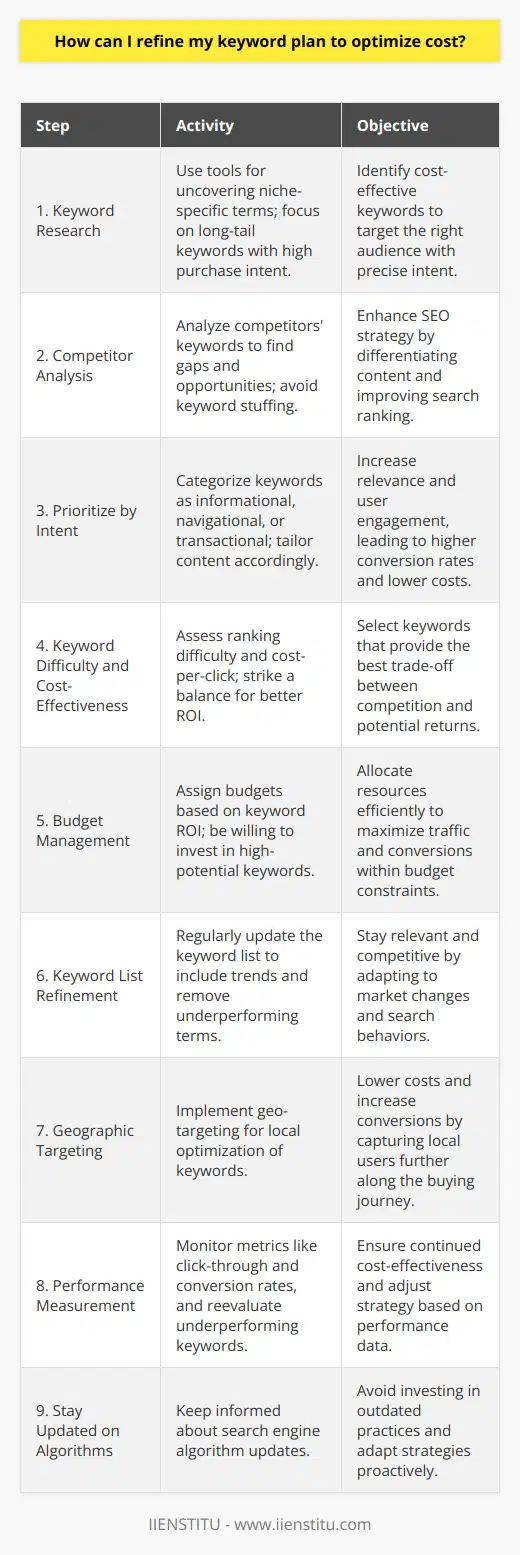
What are the benefits of seasonal keyword research?
Seasonal keyword research is essential to any successful search engine optimization (SEO) strategy. It helps businesses identify the keywords most relevant to their target audience during certain times of the year. In addition, this type of research enables companies to optimize their content and campaigns to better align with the needs and interests of their consumers.
One of the primary benefits of seasonal keyword research is that it allows companies to identify the most relevant keywords for their target audience at any time. For example, during the holiday season, businesses can use seasonal keyword research to identify words and phrases related to their products or services that are likely to be searched for by consumers. This insight can help them create content and campaigns more likely to be seen by their target audience, resulting in higher engagement and conversions.
Seasonal keyword research can help businesses identify new opportunities to reach their target audience. By monitoring the seasonal trends in search queries, companies can discover new topics or phrases to incorporate into their content and campaigns. This can help them reach new or underserved segments of their target audience and increase engagement.
Finally, seasonal keyword research can help businesses maximize the value of their SEO campaigns. By identifying the most relevant keywords for the season, companies can optimize their content and campaigns to ensure the maximum number of people sees them. This can help them generate more leads and convert more customers.
In summary, seasonal keyword research is a valuable tool for businesses looking to optimize their SEO campaigns. It enables them to identify the most relevant keywords for their target audience at any given time, discover new opportunities to reach their audience, and maximize the value of their SEO campaigns.
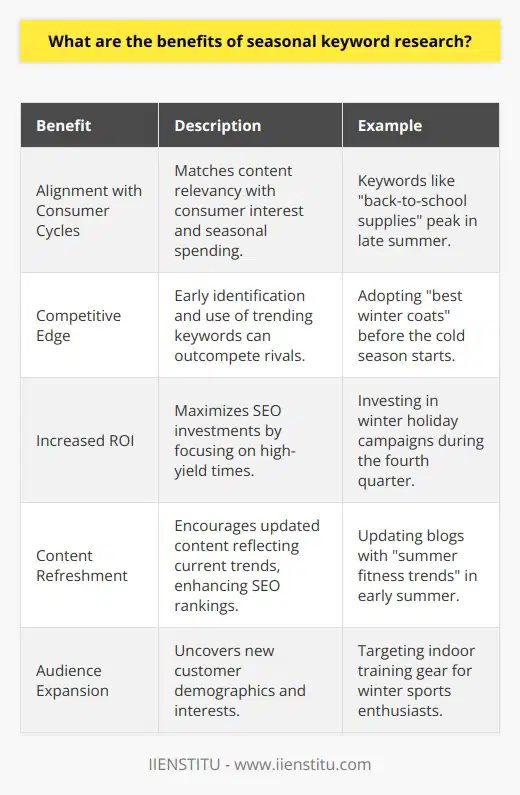
What are the essential components of a comprehensive keyword research strategy in SEO?
Keyword Selection Criteria
A comprehensive keyword research strategy for search engine optimization (SEO) involves identifying and selecting the most relevant and effective keywords to drive organic traffic to a website. Essential components include keyword relevancy, search volume, keyword difficulty, and long-tail opportunities.
Keyword Relevancy
The first component is keyword relevancy, ensuring that chosen keywords align with the content and target audience. Selecting relevant keywords guarantees that a website appears in search results for appropriate queries, attracting the right users and increasing the likelihood of conversions.
Search Volume
The second component is analyzing search volume, which measures the average number of monthly searches for a specific keyword. High search volume indicates that users frequently search for that term, thus improving organic traffic potential. However, high search volume may also imply increased competition among websites for visibility.
Keyword Difficulty
To account for competition, the keyword difficulty component should be integrated in the strategy. Keyword difficulty is a metric that estimates the complexity of ranking well for a specific keyword, considering factors like existing competition, page authority, and domain authority for websites that currently rank high. Aiming for low difficulty keywords increases the probability of ranking higher in search results.
Long-tail Opportunities
Finally, long-tail keywords should be considered as part of a comprehensive keyword research strategy. These phrases are longer and more specific, catering to narrower search intents. Due to their specificity, long-tail keywords tend to have lower search volume but higher conversion rates as they target users with clear intentions. Additionally, competition for long-tail keywords is usually lower, easing the ranking process.
In conclusion, a comprehensive keyword research strategy combines keyword relevancy, search volume, keyword difficulty, and long-tail opportunities. By carefully considering and integrating these essential components, a website can optimize its SEO efforts, enhance search result rankings, and improve organic traffic quality, ultimately boosting conversions and overall success.
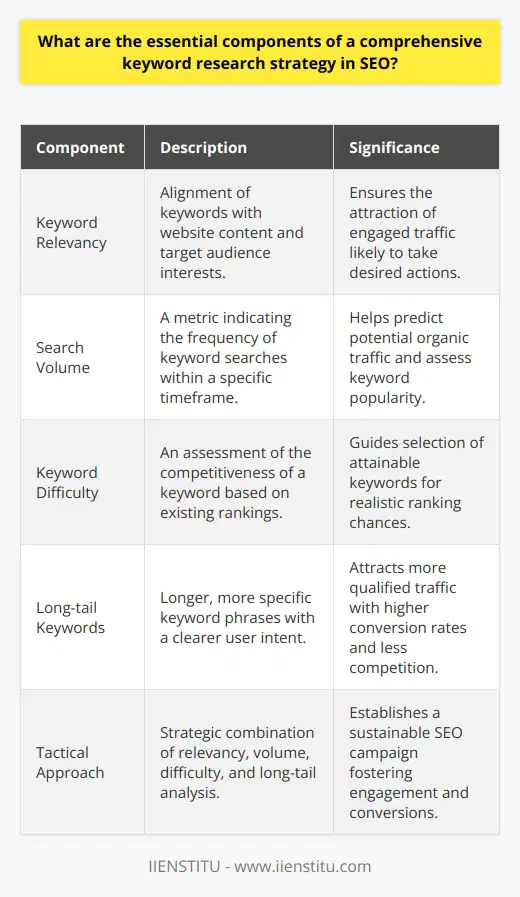
How do the different stages of SEO contribute to an effective online presence?
Understanding SEO Stages
Search engine optimization (SEO) is a crucial process for any online presence, particularly for blog posts, to ensure visibility and reach in search engine results. The various stages of SEO contribute to an effective online presence in multiple ways, including optimizing content, enhancing a website's authority, and improving user experience.
Content Optimization
The first stage of SEO includes keyword research, which allows content creators to identify relevant phrases and terms necessary for their target audience's interests. By incorporating these keywords naturally within the blog post, search engines can better understand and index the content. Additionally, well-structured content featuring headings, subheadings, and concise sentences can improve readability and bolster a blog's credibility.
On-Page SEO
On-page SEO primarily relates to the strategic use of HTML tags and other elements within a blog post. By adequately utilizing title tags, meta descriptions, and header tags, content creators can help search engines properly categorize their content. Moreover, prioritizing the use of relevant keywords within these HTML elements can bolster the ranking potential of a blog post, making it more visible to online audiences.
Technical SEO
Technical SEO, another vital stage, focuses on the website's back-end functionalities, including a website's speed, security, and mobile-friendliness. A fast-loading website with secured connections and seamless navigation can lead to improved user experience, which consequently increases the perceived quality of the blog. Furthermore, search engines are likely to rank these websites higher, ultimately augmenting a blog's online presence.
Off-Page SEO
The final stage of SEO, termed off-page SEO, deals with external factors like backlinks, social media signals, and other online mentions. By acquiring organic inbound links from credible sources, a blog can build its domain authority and improve its search engine rankings. Likewise, sharing the blog posts on social media platforms generates additional visibility, driving user engagement and amplifying the online presence.
Conclusion
In summary, the different stages of SEO are essential for establishing an effective online presence for blog posts. Utilizing each stage holistically ensures the development of well-optimized content, a user-friendly website, and an authoritative online reputation. As a result, better search engine rankings and visibility are achieved, paving the way for long-term success in the digital realm.
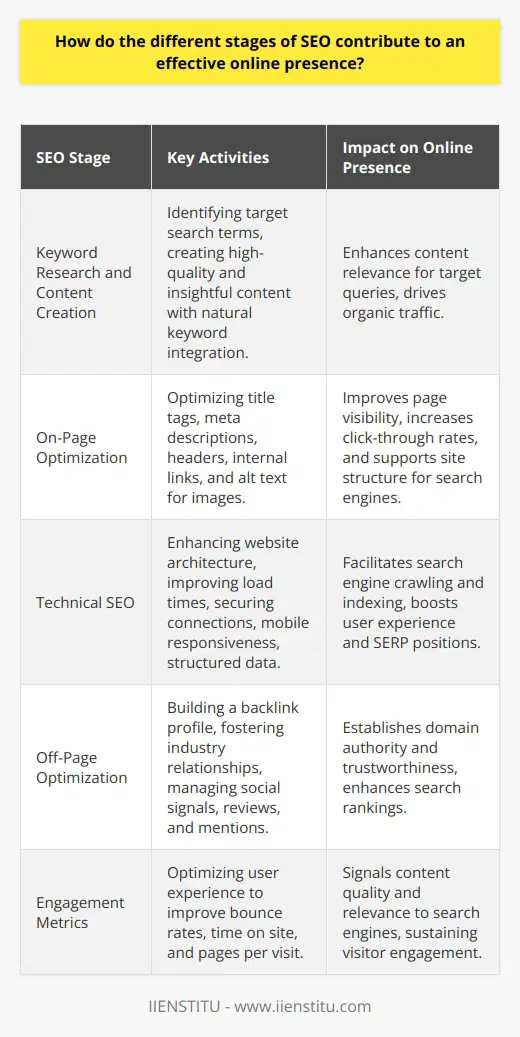
In the context of SEO, what role does keyword research play in driving organic traffic to a website?
Keyword Research Significance
In the realm of Search Engine Optimization (SEO), the practice of keyword research holds paramount importance for driving organic traffic towards a website. This process encompasses the identification and analysis of keywords and phrases that potential visitors might enter into search engines while seeking relevant information. Primarily, the core objective of keyword research lies in comprehending and gauging the demand for specific search terms, thereby enabling website owners to optimize their content and develop effective strategies to attract more visitors.
Competitive Analysis
To attain this objective, SEO practitioners need to conduct an extensive competitive analysis to find high-traffic keywords with relatively low competition. Identifying such terms allows for the creation of content that is more attuned to the audience's preferences and interests, which in turn enables search engines to discern the relevance of the website and assign it a higher ranking on the Search Engine Results Pages (SERPs). Consequently, this leads to an increase in organic traffic for the website.
Long-tail Keywords
A critical aspect of keyword research involves the utilization of long-tail keywords. Long-tail keywords, comprising of three or more words, are highly specific and often reflect a user's specific intent. By targeting such keywords, a website can produce content that directly addresses the needs of its audience, thereby enjoying greater SERP visibility and consequently experiencing a higher influx of organic traffic.
Keyword Intent
Another vital component of keyword research is to understand keyword intent, which refers to the purpose or goal behind user searches. Keyword intent can be segmented into four primary categories, namely informational, navigational, commercial, and transactional. By discerning the underlying intent of certain keywords, content creators or website owners can tailor their materials to align with the anticipated demands or expectations of internet users. This harmonization creates a more conducive environment for securing a higher search engine ranking and garnering increased organic traffic.
Ultimately, keyword research serves as the foundation upon which successful SEO campaigns are built. By analysing, understanding, and implementing high-demand keywords into a website's content, SEO practitioners can foster the growth of organic traffic and bolster the site's online visibility.
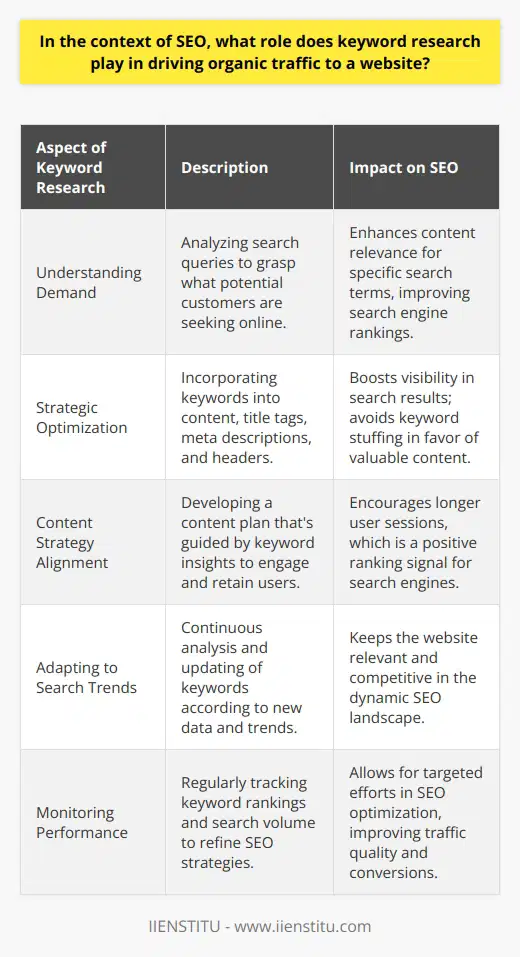
What are the 4 stages of SEO?
**Introduction to SEO Stages**
Search Engine Optimization (SEO) is a multifaceted digital marketing strategy aimed at improving a website's visibility and ranking on search engine results pages (SERPs). SEO comprises four primary stages, which are 1) keyword research, 2) on-page optimization, 3) off-page optimization, and 4) performance analysis.
**Keyword Research: Laying the Foundation**
The first stage of SEO is keyword research, which involves identifying target keywords relevant to a website's content, audience, and goals. The purpose of this stage is to find the most suitable keywords that users are likely to enter into search engines when looking for information related to the website's subject matter. The chosen keywords should have the potential to drive considerable organic traffic and deliver a competitive advantage.
**On-Page Optimization: Fine-tuning Content and Structure**
Once suitable keywords have been identified, the next stage is on-page optimization, which involves integrating the target keywords into a website's content, meta tags, and HTML code. This stage includes optimizing page titles, meta descriptions, headings, images, and URL structures to ensure that the content is both user-friendly and search engine-friendly. Moreover, it involves improving a website's overall structure, usability, and loading speed, which can significantly impact its SERP ranking.
**Off-Page Optimization: Building Authority and Credibility**
In the third stage of SEO, off-page optimization, the focus shifts to external factors that influence a website's ranking. This stage primarily centers around building a strong network of high-quality backlinks from relevant and authoritative websites, as well as engaging in social media marketing and content marketing. These activities help establish a website's credibility and authority, which are essential factors considered by search engines when ranking webpages.
**Performance Analysis: Measuring Success and Refinement**
The final stage of SEO involves performance analysis, which is the ongoing process of assessing a website's SEO strategy's effectiveness against predetermined goals and key performance indicators (KPIs). By tracking various metrics, such as organic traffic, click-through rates, bounce rates, and conversions, website owners and marketers can identify areas for improvement and refine their strategies accordingly. This stage also involves staying up-to-date with search engine algorithm updates and industry trends, ensuring the continued growth and success of a website's SEO strategy.
In conclusion, SEO is an ongoing, iterative process that involves identifying relevant target keywords, optimizing a website's content and structure, building a robust network of backlinks, and regularly analyzing performance to refine strategies. Each of these four stages plays a crucial role in enhancing a website's search engine ranking, visibility, and overall success.
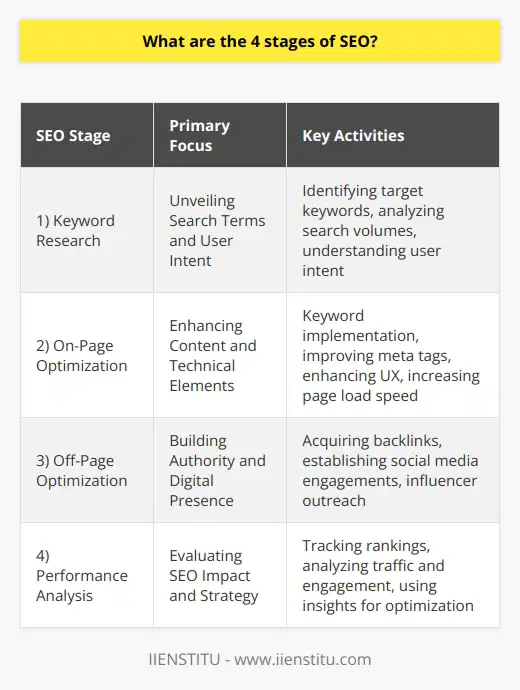
What is the phase of keyword research?
**Understanding the Phase of Keyword Research**
Keyword research is an essential process for content creators, particularly bloggers, to determine the most relevant search terms that users enter into search engines in order to optimize their content. The phase of keyword research consists of several steps that can be essential for creating and optimizing blog posts to be more visible and appealing to the target audience. These steps aim to improve the blog's search engine ranking, drive organic traffic, and ultimately increase its online presence.
**Identifying Target Audience and Goals**
The first step in the keyword research phase is to identify the target audience and establish clear goals for the blog post. This involves understanding the readers' preferences, needs, and challenges in order to develop content that caters to their interests and provides solutions.
**Generating Initial Keyword Ideas**
After defining the target audience and goals, the next step is to generate an initial list of keywords relevant to the topic of the blog post. This can be achieved by brainstorming, utilizing keyword research tools, or analyzing competitors' content to discover effective keywords.
**Evaluating Keyword Relevance and Competition**
Once a list of potential keywords has been generated, it is important to evaluate their relevance to the content and target audience as well as the level of competition for each keyword. High-relevance keywords with lower competition levels are more likely to rank higher in search engine results pages and are thus more desirable.
**Expanding and Refining the Keyword List**
Based on the evaluation of relevance and competition, content creators should expand and refine their keyword list by adding long-tail keywords, local search terms, and other variations. This helps in targeting niche audiences and achieving a wider reach.
**Selecting and Integrating Keywords into Content**
Finally, after the keyword list is refined, the most appropriate keywords should be strategically integrated into the blog post to improve search engine optimization (SEO). This involves placing the keywords in the title, headings, meta descriptions, and throughout the body of the blog post while maintaining a natural flow of content.
In conclusion, the phase of keyword research involves defining the target audience and goals, generating keyword ideas, evaluating their relevance and competition, refining the keyword list, and integrating chosen keywords into the content. By following these steps, content creators can improve their blog post's search engine ranking, drive organic traffic, and ultimately increase its online presence.
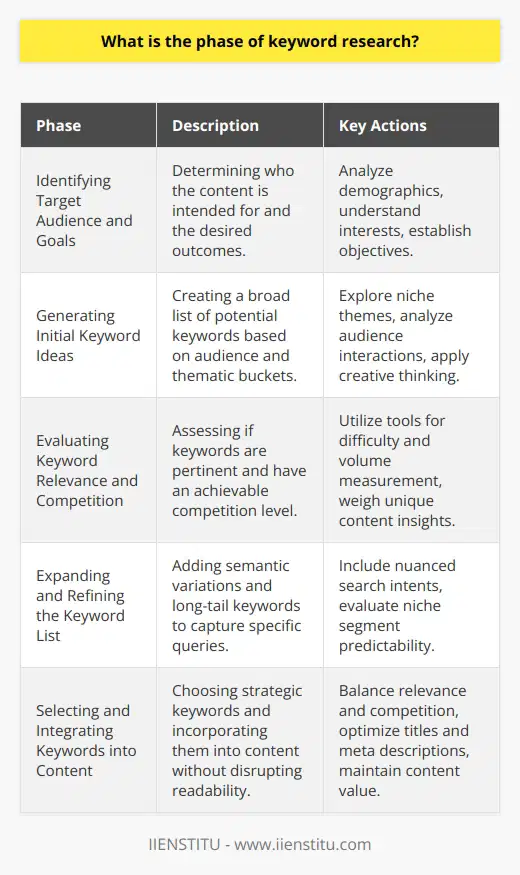
What are the 5 steps to be followed during keyword research?
Understanding Keyword Research Steps
The process of keyword research involves five essential steps. These steps aim to optimize blog content to improve visibility, attract a relevant audience, and enhance the website's search engine ranking.
Establish Goals and Objectives
Begin by setting specific goals for the content being created. Determine the target audience, the purpose of the blog post, and the desired outcomes, such as increased website traffic or improved conversion rates. Aligning content with well-defined objectives ensures a focused and effective approach to keyword research.
Analyze Competitors' Keywords
Investigate competitor's blog posts to identify the keywords they are targeting. Assess their keyword usage, the search engine ranking of their content, and the relevance of their keywords to the desired target audience. Gaining insights from competitors helps in formulating an effective keyword targeting strategy.
Generate an Initial Keyword List
Create a preliminary list of potential keywords relevant to the blog post's topic and target audience. Utilize various keyword research tools, such as Google's Keyword Planner and Moz's Keyword Explorer, to generate ideas. Include both short-tail (one to three words) and long-tail (four or more words) keywords for a balanced approach.
Evaluate Keyword Effectiveness
Consider factors like search volume, keyword difficulty, and competition level to assess the effectiveness of each keyword in the initial list. Aim to find a balance between these factors to select the most impactful keywords. For instance, high search volume keywords with low competition levels are typically more effective than high-volume keywords with high competition levels.
Refine and Monitor Keyword Performance
After finalizing the keywords, integrate them into the blog post strategically, ensuring that keyword usage is natural and does not affect the content's readability. Continuously monitor keyword performance through analytical tools, such as Google Analytics, and adjust the chosen keywords as needed to maintain optimal search engine rankings.
In conclusion, the keyword research process is a vital component of effective blog post creation. By following these five steps, blog authors can increase the visibility of their content, attract a relevant audience, and ultimately achieve their desired objectives.
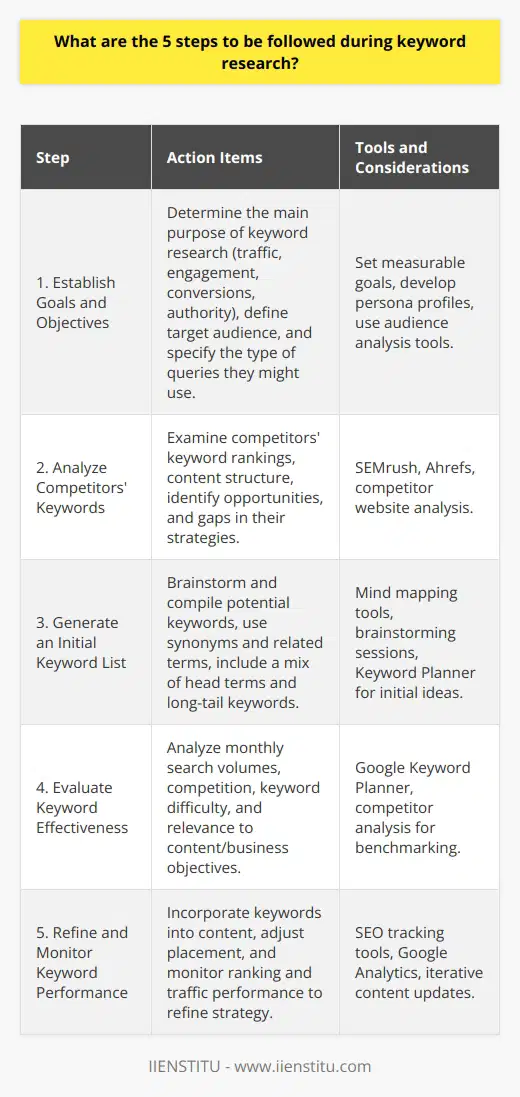
What is the significance of the keyword research process in the context of SEO?
Keyword Research and SEO
Understanding the Audience
The significance of the keyword research process in the context of search engine optimization (SEO) lies in its ability to identify relevant search terms. This information, in turn, helps content creators understand the needs and preferences of their target audience. As a result, they can create or optimize online content that caters to those needs and preferences, enhancing the chances of attracting organic traffic and improving search engine rankings.
Optimizing Content for Search Engines
Effective keyword research plays a pivotal role in determining content strategies and ensures that web pages and blog posts gain visibility on search engines. By mapping the right keywords, the chances of obtaining a higher ranking in search engine result pages (SERPs) increase, resulting in better online visibility. Furthermore, search engines like Google tend to prioritize well-optimized content, making keyword research integral to the SEO process.
Staying Ahead of Competition
Integrating the most relevant and potentially high-performing keywords enables web pages to stay ahead in the competitive digital space. Identifying and capitalizing on high-volume or low-competition keywords allow content creators to draw in greater organic traffic, strengthening their online presence. Moreover, keyword research provides valuable insights into the competitive landscape, guiding the development of strategic content that can outshine the competition.
Long-term Traffic Generation
Executing the keyword research process ensures the sustainability of long-term organic traffic generation. Analyzing keyword trends and performance over time allows content creators to optimize their website or blog content in a way that meets the evolving demands of search engines and users alike. Consequently, well-researched keywords lead to a sustained flow of website traffic, contributing to the overall success of an online business or blog.
In conclusion, the keyword research process carries immense significance in the context of SEO, as it helps content creators understand their audience, optimize content for search engines, stay ahead of the competition, and secure long-term traffic generation. Ultimately, keyword research serves as the backbone for the proficiency and effectiveness of SEO strategies in enhancing online visibility and overall success.
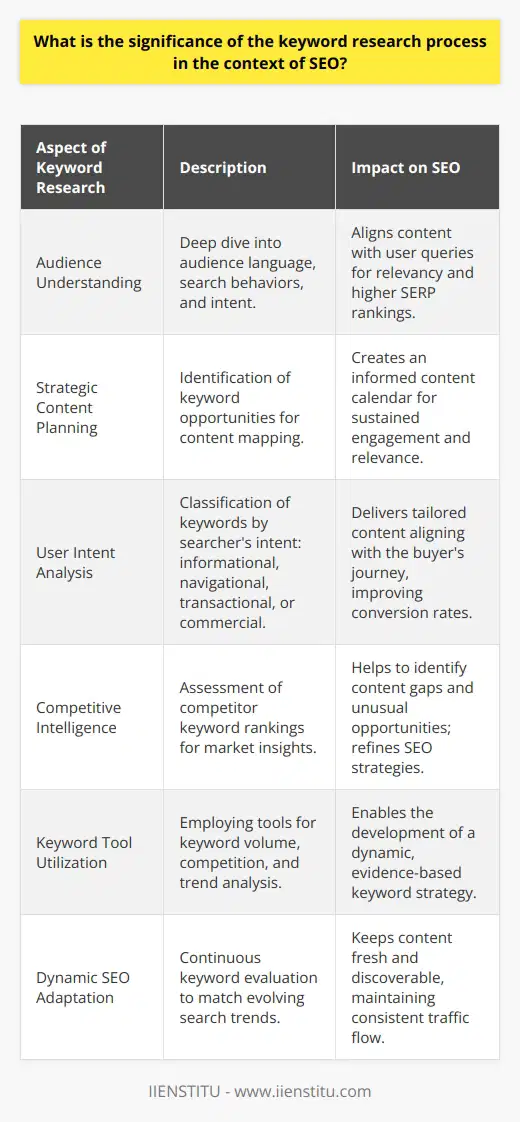
How can one effectively integrate keyword research findings into a broader SEO strategy?
Understanding Keyword Research Findings
To effectively integrate keyword research findings into a broader SEO strategy, one must initially understand its importance in influencing search engine visibility, website traffic, and content relevancy. Keywords act as a compass, guiding users in finding relevant and engaging content on search engines.
Anatomy of Comprehensive Keyword Analysis
Carrying out a comprehensive keyword analysis involves the identification of primary, secondary, and long-tail keywords. Primary keywords are the main focus of the content, while secondary keywords support and enhance the relevance of the primary ones. Long-tail keywords, on the other hand, represent unique searches comprising multiple words, often closely related to the primary and secondary keywords.
Prioritizing Keywords
Once the research is complete, it becomes crucial to prioritize keywords based on their relevance to the website's target audience, search volume, and competition. High search volume and low competition keywords are considered the most valuable since they have the potential to attract more visitors with less effort.
Optimizing On-Page Elements
In addition to generating engaging content, incorporating keywords into essential on-page elements is indispensable. These elements include the title tag, meta description, headings (H1, H2, H3), and body text. Appropriate placement and distribution of keywords within these elements enable search engines to index and rank the content effectively.
Creating User-Friendly Content
While utilizing primary and secondary keywords, it is vital to maintain a natural writing style, focusing on reader-friendly content. Overstuffing content with keywords can lead to poor readability and potential penalties from search engines. Instead, consider crafting high-quality, genuinely informative content that resonates with the target audience.
Emphasizing Internal and External Links
Integrating keywords not only involves their use within the content but also linking to reputable external sources and internally to other relevant pages on the website. It is highly advised to use target keywords in anchor texts for hyperlinks when applicable. This practice boosts the SEO value and overall user experience.
Monitoring Performance and Adjustments
Constantly monitoring keyword performance, evaluating search engine rankings, and analyzing website traffic is critical to adjusting and refining the SEO strategy as needed. This practice facilitates a better understanding of user behavior and helps detect new opportunities and trends in the ever-evolving digital landscape.
In conclusion, effectively integrating keyword research findings into a broader SEO strategy involves understanding the importance of keywords, conducting comprehensive keyword analysis, prioritizing relevant keywords, optimizing on-page elements, creating user-friendly content, emphasizing internal and external links, and constantly monitoring performance to make informed adjustments.

What are some best practices for conducting thorough and effective keyword research in SEO?
Understanding the Intent
One essential practice in effective keyword research for Search Engine Optimization (SEO) is understanding the intent behind users' search queries. This involves anticipating the problems and desires of potential visitors and addressing them by providing relevant and valuable content. Analyzing the top-ranking sites for specific keywords can offer valuable insights into user intent and help tailor content accordingly.
Implementing Long-Tail Keywords
Incorporating long-tail keywords in SEO strategies is another best practice. These are phrases that are usually more specific and longer than common head keywords, resulting in lower search volumes but higher conversion rates. By targeting these keywords, content creators can appeal to a niche audience, offering specific and valuable information that yields better user satisfaction and SEO performance.
Exploring Competitor Strategies
Examining the competition's keyword strategies provides an opportunity to identify keyword gaps and areas for improvement. By analyzing competitors' highly ranking content, one can uncover what keywords they are targeting and evaluate their efficacy in terms of driving traffic and engagement. Additionally, it offers a benchmark for assessing the effectiveness of one's own keyword research and assists in refining the SEO approach.
Leveraging Keyword Research Tools
Utilizing keyword research tools is another best practice for conducting thorough and effective keyword research. Popular tools such as Google Keyword Planner, Moz Keyword Explorer, or SEMrush offer valuable data about search volume, keyword difficulty, and competition levels. They also suggest additional relevant keyword ideas that content creators may not have initially considered.
Incorporating Semantic SEO
Employing a semantic SEO approach can also considerably improve keyword research by considering the relationships between words and the context in which they appear. This method entails identifying related keywords and concepts that are relevant and meaningful to the primary keyword being targeted. By incorporating these related terms in content, it is possible to provide additional value and enhance the user experience.
Monitoring and Adapting Strategies
Finally, SEO is a dynamic field, and therefore, monitoring and adapting keyword research strategies is vital. Performance metrics, such as search engine rankings, click-through rates, and conversions, should be regularly evaluated to identify trends and areas for improvement. Continuously refining and updating keyword strategies ensures long-term success in the ever-changing landscape of SEO.
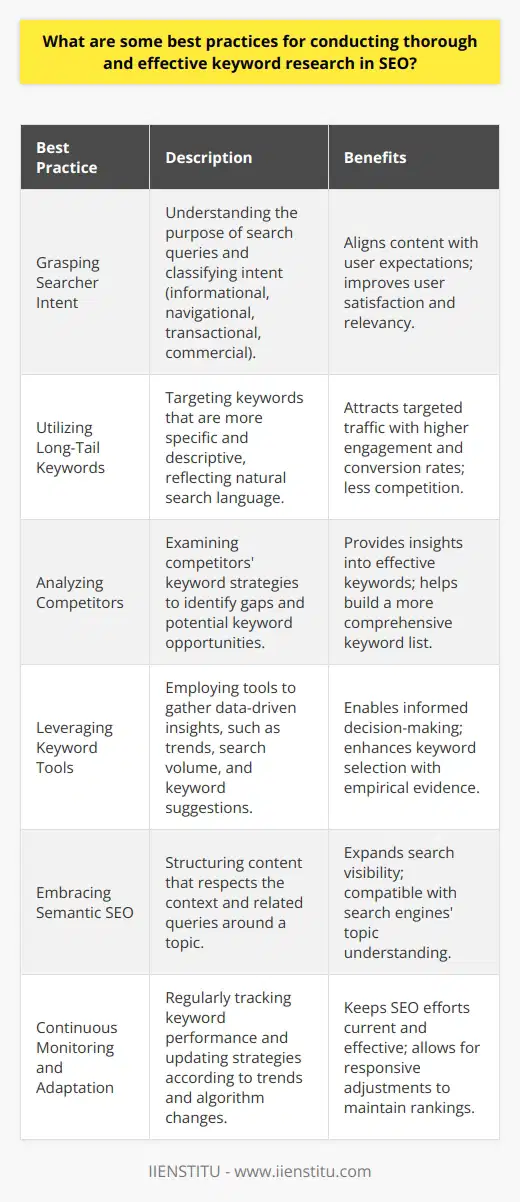
What are the fundamental principles underlying a successful keyword research process in SEO?
Fundamental Principles of Keyword Research
Understanding Target Audience
A critical component of a successful keyword research process in SEO is understanding the target audience. Through market research, businesses can identify their primary customer base and what they are searching for online. By accurately tapping into user search patterns and preferences, businesses can better tailor their content to match user intent.
Selecting Appropriate Keywords
Additionally, a successful keyword research process involves the selection of the most appropriate keywords which reflect the essence of the content. Broad and generic keywords can decrease the chances of visibility in search engine results pages (SERPs). In contrast, long-tail and specific keywords not only lead to better search rankings but also attract a more focused audience interested in the content.
Utilizing Keyword Research Tools
Keyword research must involve the utilization of various tools that provide insights into which keywords perform well and hold the most potential in terms of search volumes and competition. Tools such as Google's Keyword Planner, SEMrush, Ahrefs, and Moz can help businesses identify keywords and analyze their effectiveness within the context of the broader SEO strategy.
Analyzing Competitors
Effective keyword research should also take into account the keywords used by competitors in the market. Observing the keyword strategies employed by others allows businesses to understand which terms have proven successful and which may be oversaturated. Analyzing competition helps businesses refine their keyword selection, enabling them to capitalize on under-explored niche markets.
Employing LSI (Latent Semantic Indexing) Keywords
Lastly, a robust keyword research process should investigate LSI keywords. LSI keywords are synonymous or related terms that search engines associate with the main keywords. By including these related terms in content, businesses can broaden their visibility and improve the chances of appearing higher in SERPs. This technique also enhances content quality and comprehensiveness by ensuring a natural flow of related information.
In conclusion, a successful keyword research process in SEO entails understanding the target audience, selecting appropriate keywords, utilizing keyword research tools, analyzing competitors, and employing LSI keywords. By adhering to these fundamental principles, businesses can improve their visibility in SERPs and establish a strong online presence.
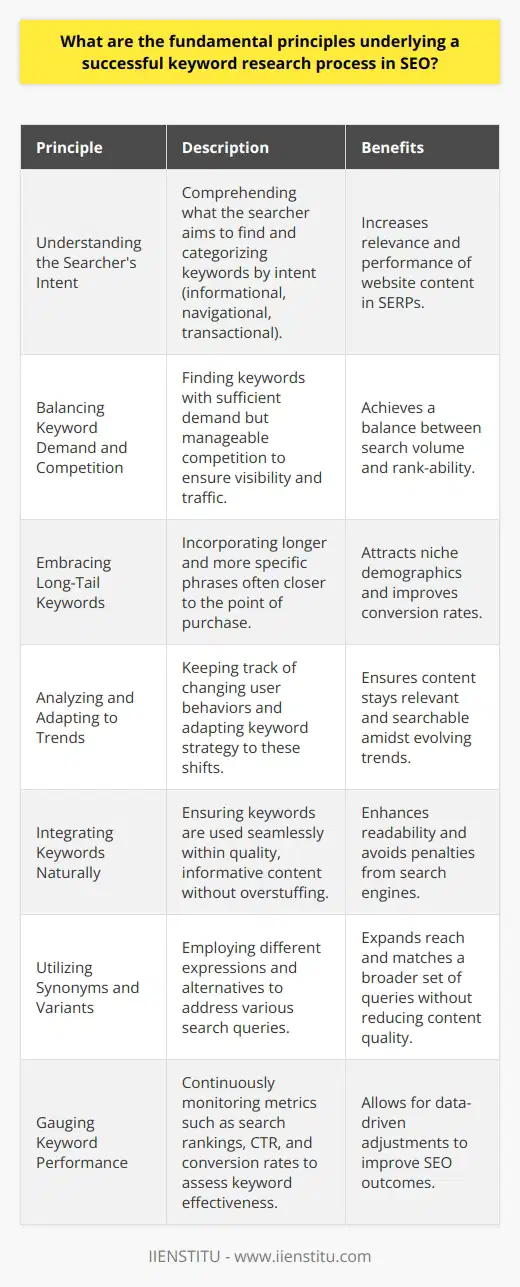
How does the keyword research phase play a crucial role in the overall SEO strategy of a website?
Keyword Research: Cornerstone of SEO
The keyword research phase is crucial in shaping the overall SEO strategy of a website as it provides the foundation for content creation and optimization. By identifying the relevant search terms and phrases most frequently used by the target audience, website owners can tailor their content to meet user needs and improve search rankings.
Understanding User Intent
An essential aspect of keyword research involves understanding user intent, which reflects the purpose and motivation behind a search query. This information helps in crafting content that aligns with user expectations, thereby increasing engagement, dwell time, and overall website performance.
Competition Analysis
During the keyword research phase, analyzing the competition for particular keywords is instrumental in determining the feasibility of ranking for those terms. By evaluating the strengths and weaknesses of competing websites, one can make informed decisions on which keywords to target for maximum ROI.
Long-Tail Keywords
A focus on long-tail keywords, which are highly specific, low-competition search terms, often results in a greater likelihood of achieving top search rankings. Strategically prioritizing these keywords within the content can contribute significantly to the overall SEO success of a website.
Categorization and Prioritization
Categorizing and prioritizing keywords enables efficient workflow in content creation and optimization efforts. Additionally, it allows for a targeted approach to developing a site's information architecture, which supports improved user experience and search engine indexing.
Monitoring and Adjusting
Continually monitoring the performance of targeted keywords ensures up-to-date understanding of search trends and user behavior. This enables website owners to adjust their SEO strategies accordingly, optimizing budget allocation and efforts for maximum results.
In summary, the keyword research phase plays a pivotal role in establishing a website's SEO strategy. It not only informs content creation and optimization efforts but also contributes to the overall user experience and performance of a website, ultimately leading to better search rankings and online visibility.
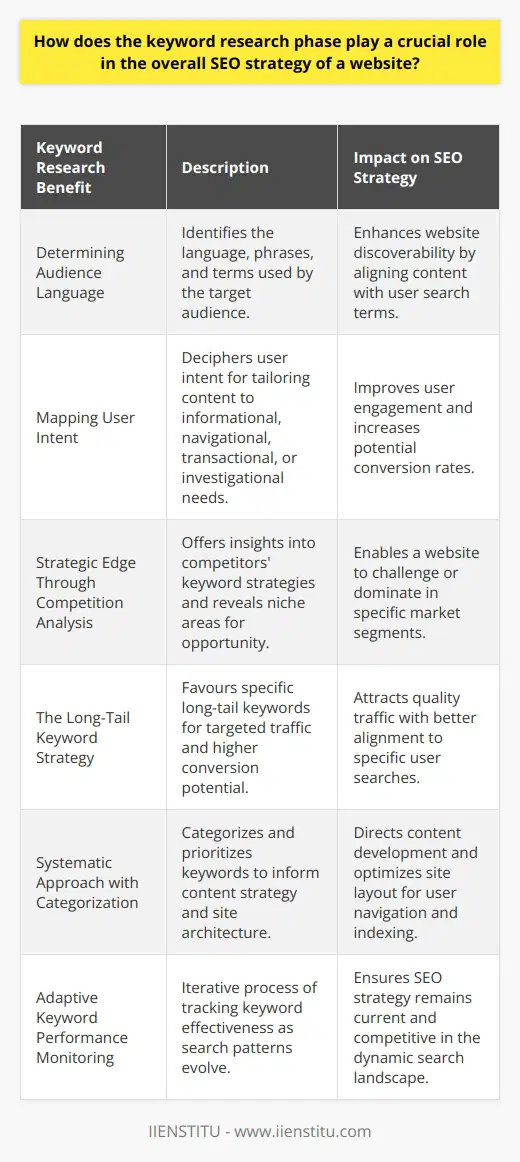
Can you elaborate on the significance of long-tail keywords and their impact on both SEO and user experience?
Understanding Long-Tail Keywords
Long-tail keywords are highly specific, multi-word phrases that users type into search engines. Their significance lies in the fact that they help target a niche audience, offering higher conversion rates compared to shorter, broader keywords. A clear understanding of long-tail keywords serves an essential role in a comprehensive SEO strategy and enhancing user experience on web platforms.
Impact on SEO
The importance of long-tail keywords for SEO is multifaceted. First, long-tail keywords face less competition, making it easier for a website to rank highly in search engine result pages (SERPs). By targeting these keywords, website owners can achieve a higher search position and drive more organic traffic to their site. Additionally, search engines like Google reward websites for providing relevant and valuable content. Content that focuses on specific long-tail keywords aligns with users' search intent, prompting search engines to rank the site higher for those targeted phrases.
Increased User Experience
Focusing on long-tail keywords leads to a better user experience. Websites that create content tailored to these niche queries effectively address specific user needs. As a result, users are more likely to engage with the website, spend more time browsing its pages, and return to it in the future. Serving the users' search intent is likely to foster brand loyalty and lead to higher conversion rates. Another advantage comes from voice search technology, which relies heavily on long-tail keyword searches.
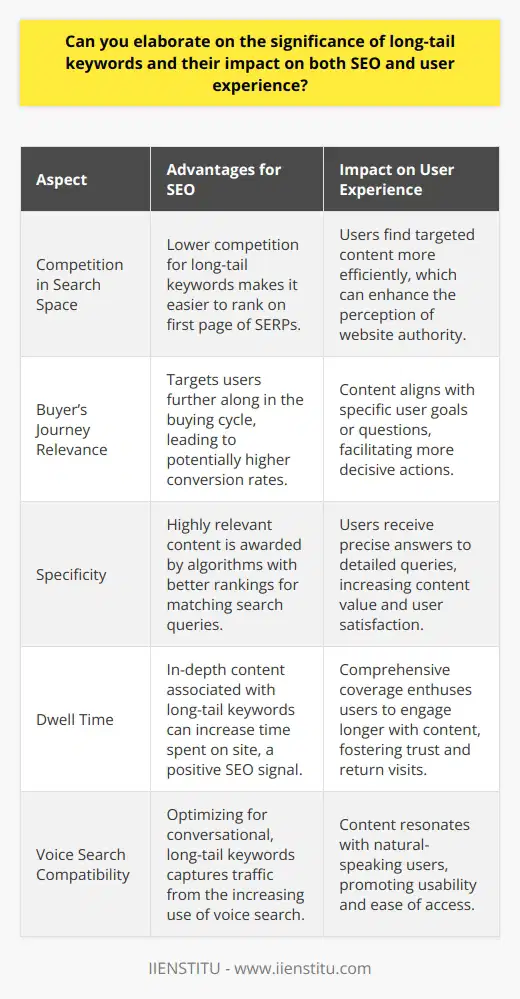
What are the six phases of SEO and how do they contribute to a comprehensive digital marketing strategy?
**Introduction to SEO Phases**
Search engine optimization (SEO) is an integral component of a comprehensive digital marketing strategy. It is a continuous process designed to enhance a website's visibility on search engines, thus attracting more organic traffic. The six phases of SEO include research, planning and strategy, on-page optimization, off-page optimization, technical SEO, and measurement and reporting. Each phase plays a distinct role in ensuring a successful digital marketing campaign, as discussed below.
**Research Phase**
The research phase of SEO involves analyzing competitor websites and understanding the target market. This phase helps identify relevant keywords and phrases that potential customers use to find products or services similar to what the business offers. These insights are vital for creating a solid SEO plan aimed at outranking competitors in search results.
**Planning and Strategy**
After thorough research, the next phase involves approaching the right SEO tactics and establishing target goals. This step may include segmenting keywords, creating content plans, and deciding on the best SEO techniques to implement, like local SEO or international SEO. A well-planned SEO strategy helps businesses stay focused on achieving measurable results, ensuring a cohesive digital marketing campaign.
**On-Page Optimization**
In this phase, businesses optimize their website's content, metadata, headlines, and images to boost their search engine rankings. This includes incorporating targeted keywords and relevant information into the website, making it more appealing and accessible to both search engines and users. Well-optimized websites receive more traffic, create a good user experience, and ultimately raise brand awareness and credibility.
**Off-Page Optimization**
Off-page optimization refers to activities promoting a website's authority and reputation outside its domain. This may include link building through guest blogging, social media engagement, and influencer collaborations. By creating connections with other websites, businesses demonstrate their expertise and trustworthiness, which search engines take into account when ranking websites.
**Technical SEO**
Technical SEO enhances the technical aspects of a website, such as its backend structure, loading speed, mobile responsiveness, and security. This ensures users have a seamless experience when browsing the website, which in turn, helps maintain customer retention and brand loyalty. Search engines favor user-friendly websites, so technical SEO is crucial for improving search rankings.
**Measurement and Reporting**
Lastly, measurement and reporting involve tracking and analyzing website performance, user behavior, and keyword rankings. This data provides valuable feedback needed to refine and adjust an SEO strategy for continuous improvement. By keeping tabs on their website's performance, businesses can make informed decisions, taking into account changing trends and user preferences to maintain a competitive edge in the digital marketing landscape.
In conclusion, the six phases of SEO work together to create a comprehensive and effective digital marketing strategy. By sequentially addressing each phase, businesses can not only enhance their website's visibility on search engines but also outperform competitors and better connect with their target audience.
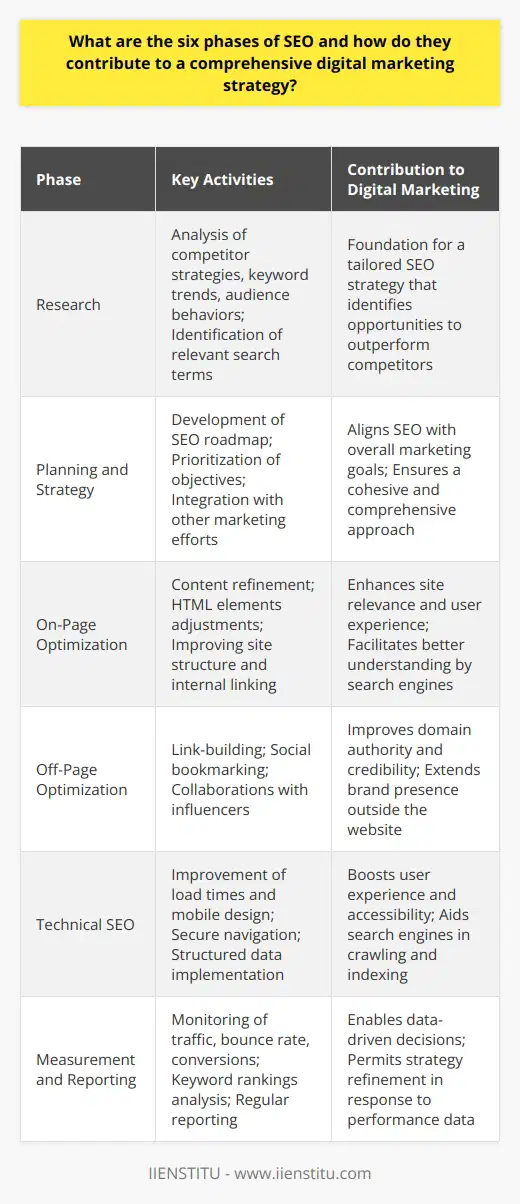
What key factors should be considered during the keyword research process to ensure an effective SEO plan?
Understanding Target Audience
The first key factor to consider during the keyword research process is understanding the target audience. It is essential to identify their preferences, interests, and the language they use when searching online. This will help in selecting relevant keywords that are more likely to attract the desired audience.
Competitor Analysis
Competitor analysis is another important factor in determining effective keywords. By examining the keywords that competitors are using to rank well, it is possible to identify gaps and opportunities for improvement. This will aid in crafting an SEO plan that can effectively compete and outperform competitors.
Search Volume and Keyword Difficulty
In addition to selecting relevant and competitive keywords, it is crucial to consider their search volume and keyword difficulty. High search volume indicates a strong interest in the topic, while low keyword difficulty suggests that it may be easier to rank for these terms. Balancing these factors will ensure a well-rounded SEO plan that targets popular, yet achievable keywords.
Long-tail Keywords
The inclusion of long-tail keywords should also be prioritized during the keyword research process. These are longer, more specific phrases that are less competitive and can help reach a more targeted audience. Long-tail keywords often have a higher conversion rate as they appeal directly to users' precise search intent, leading to better user engagement and ultimately, better search rankings.
Keyword Variations and Synonyms
Lastly, incorporating keyword variations and synonyms is beneficial in ensuring an effective SEO plan. Since users often use different terms or phrases when searching for information, incorporating a diverse range of keywords can help improve the chances of the blog post being discovered by a wider audience.
In conclusion, several key factors should be considered during the keyword research process to ensure an effective SEO plan for a blog post. Understanding the target audience, conducting competitor analysis, assessing search volume and keyword difficulty, focusing on long-tail keywords, and including keyword variations and synonyms are all essential elements to develop a well-rounded and successful SEO strategy.
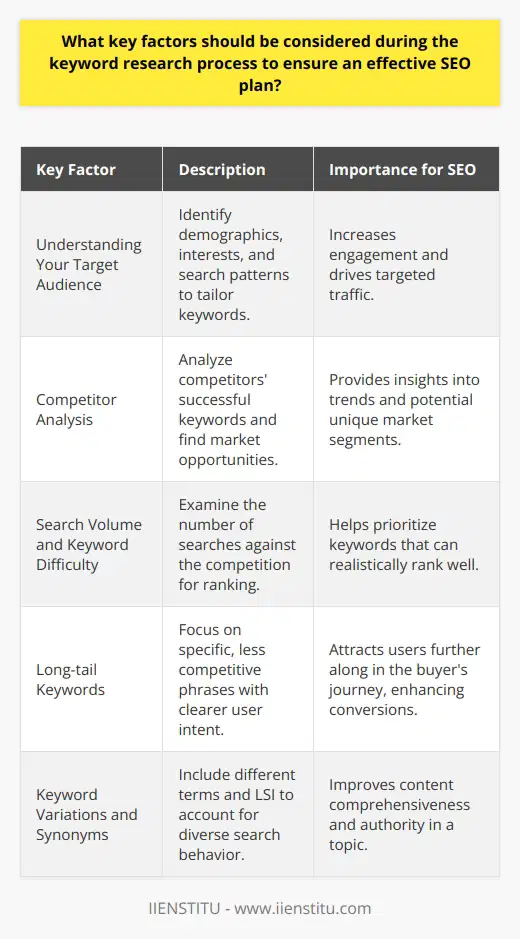
How does understanding the different phases of keyword research help in optimizing a website's organic search performance?
Understanding Keyword Research Phases
An essential aspect of optimizing a website's organic search performance is conducting comprehensive keyword research, which ensures that the website's content is relevant and targets the right audience. Understanding the different phases of keyword research plays a crucial role in this process, as it affects virtually every aspect of SEO and content planning.
Phase 1: Identifying Core Keywords
The first phase in keyword research involves identifying core keywords that are closely related to the website's main topic or industry. These keywords serve as the foundation for further research and content creation, ensuring that the website effectively targets its primary audience.
Phase 2: Expanding on Core Keywords
Once the core keywords are identified, the next phase involves expanding on these keywords by generating an extensive list of related terms and phrases. This process ensures that the website addresses relevant subtopics and caters to various search queries entered by users.
Phase 3: Analyzing Keyword Competition
Analyzing keyword competition is a vital phase in keyword research, as it helps website owners identify their direct competitors in organic search results. This information allows them to make strategic decisions about the type of content to create and determine which keywords to prioritize or target for better rankings.
Phase 4: Assessing Keyword Search Volume
One of the primary reasons for conducting keyword research is to identify keywords with high search volume. By understanding this aspect, website owners can target keywords that attract a significant number of searches, thereby increasing the likelihood of generating organic traffic to their site.
Phase 5: Organizing and Prioritizing Keywords
The final phase of keyword research involves organizing and prioritizing the keywords unearthed throughout the research process. This step allows website owners to create a structured keyword plan, ensuring that their content effectively targets their chosen keywords and caters to the audience's needs.
In conclusion, understanding the different phases of keyword research is vital for optimizing a website's organic search performance. By identifying core keywords, expanding on them, analyzing competition, assessing search volume, and organizing the results, website owners can craft an effective SEO strategy that attracts the right audience and enhances their online visibility.
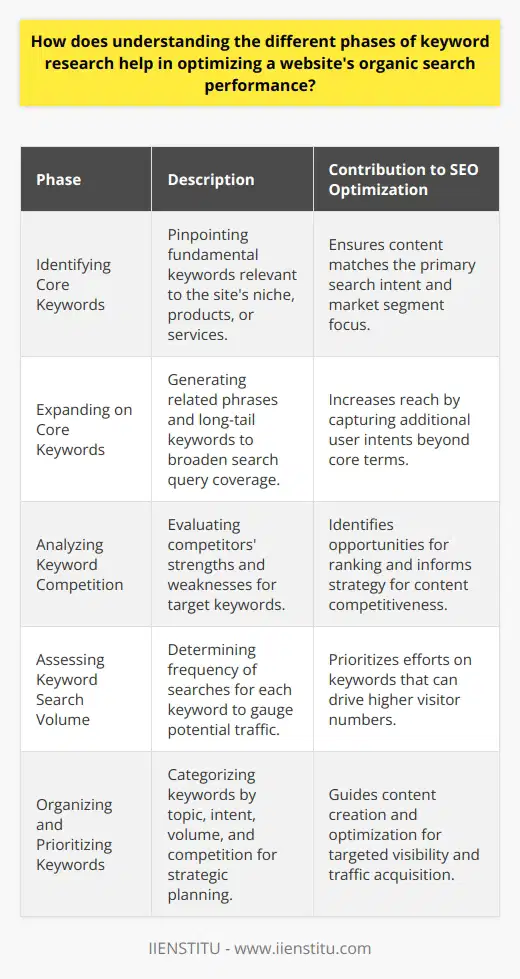
What are the elements of keyword research in SEO?
**Understanding Keyword Research**
Keyword research is a critical aspect of search engine optimization (SEO) and involves identifying relevant words and phrases that people commonly use in search engines. The main elements of keyword research include:
**1. Identifying Target Keywords**
The first step in keyword research is identifying the target keywords or keyphrases that are most relevant to the content being produced. This decision is based on understanding the target audience's needs and preferences, their common questions or concerns, and the language they use to describe the topic.
**2. Analyzing Keyword Difficulty**
Once the target keywords are identified, the next step is to analyze their difficulty level. Keyword difficulty refers to the competitiveness of a keyword in search engine rankings, which is determined by various factors such as search volume, the number of existing pages targeting the same keyword, and the quality of the competing pages.
**3. Assessing Keyword Popularity**
Keyword popularity measures the search volume, or the number of times users search for a particular keyword. It is essential to consider the popularity of the target keywords because high search volume indicates high demand, which leads to increased visibility and potential traffic for the content.
**4. Evaluating Keyword Relevance**
Relevance of a keyword is the degree to which the keyword aligns with the content and target audience. Selecting highly relevant keywords ensures that the content will satisfy users' search intent, thereby increasing the likelihood of click-throughs and conversions.
**5. Identifying Long-Tail Keywords**
Long-tail keywords are more specific, longer keyphrases that typically have lower search volume but higher conversion rates. Focusing on long-tail keywords is a valuable strategy for targeting niche markets and attracting quality traffic.
**6. Utilizing Keyword Research Tools**
Various keyword research tools are available to help identify and analyze keywords, such as Google Keyword Planner, Moz's Keyword Explorer, or SEMrush. These tools provide insights into search volume, keyword difficulty, and related keywords, assisting in the process of selecting highly effective target keywords.
In conclusion, keyword research is essential in optimizing content for search engines and attracting targeted traffic. Understanding and implementing the elements of keyword research, including identifying target keywords, analyzing difficulty, assessing popularity, evaluating relevance, focusing on long-tail keywords, and utilizing research tools, can significantly enhance the effectiveness of SEO strategies and drive the success of a blog post or website.

How can one effectively identify and prioritize target keywords based on search volume, competition, and relevance to the target audience?
Understanding Keyword Metrics
Effectively identifying and prioritizing target keywords requires a comprehensive analysis of three main factors: search volume, competition, and relevance to the target audience. Each of these factors plays a significant role in determining the potential success of a keyword strategy.
Analyzing Search Volume
Search volume refers to the number of times users search for a particular keyword within a given time frame, usually monthly. Utilizing keyword research tools, such as Google's Keyword Planner or Moz's Keyword Explorer, can provide data on search volumes. When selecting target keywords, prioritizing those with higher search volume can lead to increased visibility and traffic.
Assessing Competition
Competition is another essential factor to consider when selecting target keywords. Keywords with high search volume often come with increased competition, making it difficult to rank highly in search engine results. To evaluate keyword competition, researching the websites that currently rank for the target keywords can give insights into the competitive landscape. It is crucial to weigh the balance between search volume and competition to identify keywords that provide the best opportunity for ranking success.
Determining Audience Relevance
Lastly, ensuring that the chosen keywords are relevant to the target audience is paramount. Considering the users' search intent and how it aligns with the blog content can determine the relevance of the keywords. This can involve identifying the user's needs, questions or problems, and then selecting keywords that show a blogger's content can fulfill those needs.
Implementing Keyword Grouping
Keyword grouping can further enhance effective keyword identification and prioritization. By clustering semantically related keywords, bloggers can create content that addresses various aspects of a topic in a single post. This strategy allows for improved Search Engine Optimization (SEO) and ensures a more comprehensive coverage of the subject matter.
Adapting to Emerging Trends
Monitoring and adapting to changes in keyword trends can keep blog content current and relevant. Continually reevaluating keyword performance using analytics tools and responding to fluctuations in search volume or competition will help refine and maintain an effective keyword strategy.
In conclusion, effective identification and prioritization of target keywords entail a multifaceted approach. By considering search volume, competition, and audience relevance, as well as implementing keyword grouping and responding to emerging trends, bloggers can optimize their keyword strategy and enhance their blog's visibility and success.
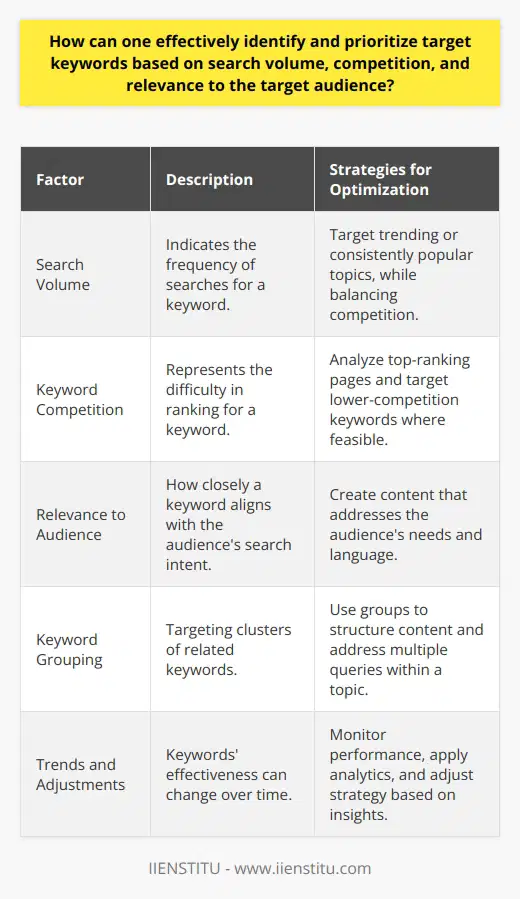
What strategies should be employed to consistently track and analyze keyword performance in order to refine and adapt an SEO strategy over time?
Tracking and Analyzing Keyword Performance
To effectively monitor and analyze keyword performance for an SEO strategy, multiple strategies should be employed. These methods include regularly tracking keyword rankings, utilizing web analytics, and conducting content audits. These strategies facilitate data-driven adjustments that optimize the SEO strategy over time.
Keyword Ranking Reports
Monitoring keyword rankings consistently provides valuable insights into how well a blog post is performing in search engines. Free and paid SEO tools, such as Google Analytics and Moz, offer reporting features that show the position of a blog's targeted keywords. These tools aid in recognizing fluctuations in search rankings and provide information necessary for refining the SEO approach.
Web Analytics Data
Using web analytics platforms like Google Analytics is crucial for identifying website traffic trends, user behavior, and engagement metrics, such as bounce rate and time on page. These data points, when analyzed in conjunction with keyword ranking reports, support the identification of high-performing and underperforming keywords. This information can direct the modifications needed to enhance a blog post's SEO strategy for greater visibility and engagement.
Content Audits
Regularly conducting content audits allows for the assessment of individual blog posts through the examination of metrics, such as organic search traffic, page views, and social shares. Content audits enable the identification of blog posts that may benefit from optimizations, such as updated content, improving keyword usage or enhancing metadata. Additionally, audits can reveal blog posts that generate excellent results, providing insights for incorporating successful SEO strategies into future content.
Adjust and Optimize
Combining the data gathered from keyword ranking reports, web analytics, and content audits, it is possible to make informed decisions to adjust and optimize the SEO strategy over time. These adjustments may include enhancing underperforming content, repurposing successful posts, or developing new content targeting emerging and relevant keywords. This continuous cycle of tracking, analyzing, and refining ensures an adaptable and evolving SEO strategy that maximizes a blog's online presence and performance.
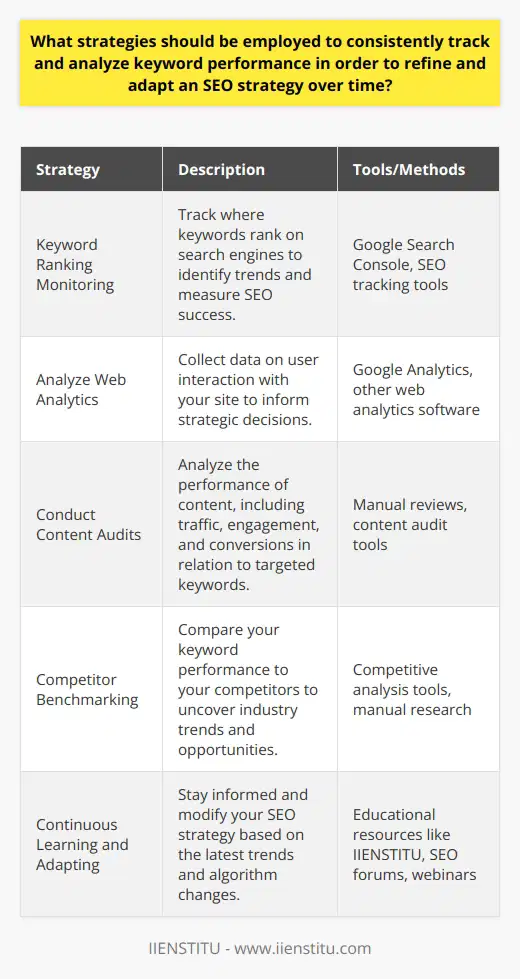
What are the critical factors to consider when selecting keywords to target in an SEO strategy?
Keyword Relevance
A crucial factor to consider when selecting keywords for an SEO strategy is their relevance to the blog's content. It is essential to choose terms that accurately represent the ideas and topics covered, ensuring a smooth and beneficial reading experience for users. Furthermore, relevant keywords boost the site's credibility and search engine ranking.
Search Volume
Another key aspect to evaluate is the search volume associated with potential keywords. This refers to how frequently users search for specific terms. Targeting high-search volume keywords can significantly increase the visibility of the blog post and attract a broader audience, ultimately driving organic traffic to the website.
Competition
An essential factor in keyword selection is the level of competition for each term. It is critical to assess the competitive landscape by identifying the existing content sources and their respective search engine rankings for the targeted keywords. This analysis helps to establish which keywords are viable options to improve the site's visibility and outrank competitors.
Keyword Difficulty
Closely related to competition, keyword difficulty measures how challenging it will be to rank for specific terms. Ideally, SEO strategists should target keywords with low-to-moderate difficulty levels, as these are the easiest to rank higher in search engine results. Selecting keywords with a lower degree of difficulty also requires fewer resources, making the process more efficient and cost-effective.
Long-Tail Keywords
Special attention should be given to long-tail keywords, which are longer and more specific phrases. This type of keyword often has less competition and targets a niche audience looking for specific information. Consequently, long-tail keywords contribute to improving the blog post's search ranking, lowering bounce rates, and increasing the chances of driving qualified traffic to the website.
Keyword Intent
Lastly, understanding keyword intent is fundamental to crafting a successful SEO strategy. Keyword intent signifies the motivation behind users' search queries, such as informational, navigational, or transactional purposes. By selecting keywords that align with the intended audience's purpose, SEO strategists can efficiently target and fulfill users' needs, resulting in higher search engine ranks and increased user satisfaction.
In conclusion, when devising an SEO strategy for a blog post, it is essential to consider keyword relevance, search volume, competition, difficulty levels, the use of long-tail keywords, and keyword intent. These critical factors will ensure a well-rounded approach to keyword selection, which will ultimately lead to increased visibility and organic traffic for the blog post.
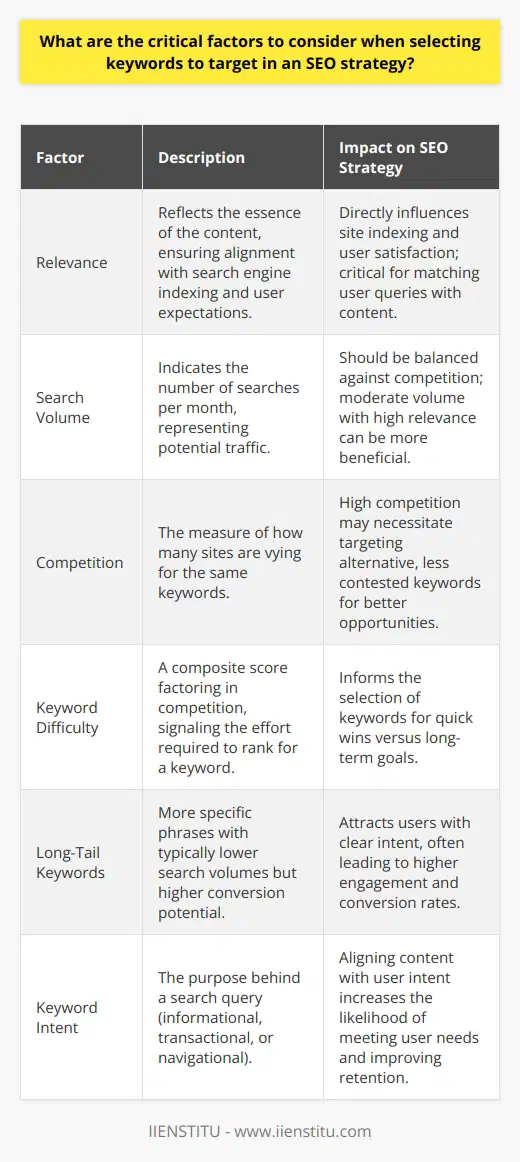
How does long-tail keyword research differ from general keyword research and what impact can it have on overall SEO efforts?
Distinguishing Long-Tail and General Keyword Research
Long-tail keyword research refers to the process of identifying specific and niche search phrases that have lower search volumes, while general keyword research focuses on broader terms with comparatively higher search volumes. These distinct approaches significantly impact an organization's SEO efforts, shaping visibility in search engine results pages (SERPs) and overall website optimization.
Advantages of Long-Tail Keywords
The long-tail keyword strategy effectively targets a particular audience segment, typically resulting in higher conversion rates. This specificity in search queries indicates higher user intent to engage or purchase when compared to general keywords. Furthermore, long-tail keywords are easier to rank for due to reduced competition, simplifying market entry for new and smaller businesses.
Tailoring Content to Niche Audiences
By utilizing long-tail keywords, content creators can develop pieces tailored to address specific needs of their target audience. The insightful information offered by long-tail keyword research guides website optimization, aiding in creating high-quality, relevant, and valuable content. This, in turn, fosters reader loyalty and positive user experience.
Impact on Search Engine Rankings
Long-tail keywords can improve search engine rankings by resulting in higher click-through rates (CTR) and lower bounce rates. Higher CTR increases the probability of users spending more time on a website, hence enhancing organic search visibility. Additionally, this drives down the bounce rate, which search engines interpret as an indicator of quality content, further improving search rankings.
Balancing Keyword Strategies
In conclusion, long-tail keyword research diverges from general keyword research in terms of focus, specificity, competition, and potential impact on SEO efforts. Implementing a balanced approach that incorporates both long-tail and general keywords can optimize website visibility on SERPs and cater to diverse audiences. While long-tail keywords facilitate higher conversions and tailored content, general keywords generate broader traffic. Adapting both strategies ensures a holistic SEO approach, driving better engagement and digital performance.
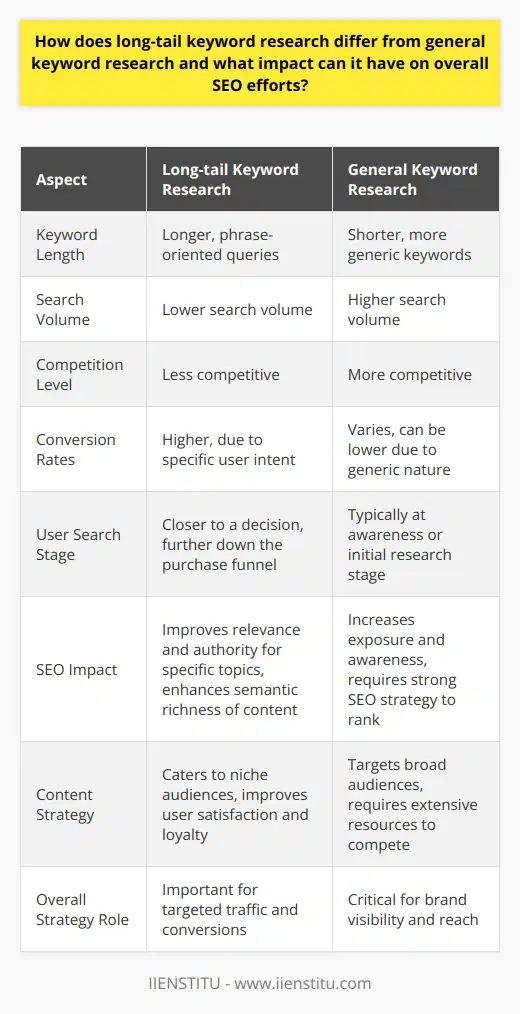
In what ways can one effectively utilize competitor analysis to inform and enhance their own keyword research process in SEO?
Understanding Your Competitor's Keyword Strategy
One way to effectively utilize competitor analysis in SEO is to examine their keyword strategy. By understanding the keywords that competitors are targeting, marketers can identify gaps in their own keyword targeting efforts and make adjustments accordingly.
Analyzing Ranking Keywords
To begin, marketers should investigate which keywords their competitors are ranking for. Tools such as SEMrush and Ahrefs can offer insights into the top-ranking keywords for a given competitor. These insights provide a starting point for incorporating similar or related keywords into one's own content.
Evaluating Keyword Relevancy
In addition to examining ranking keywords, it is important to understand the relevance of keywords to the target audience. By comparing a competitor's keyword use with one's own, marketers can identify new, high-priority keywords to incorporate. For example, if a competitor is targeting a keyword that has substantial search volume and relevance to the target audience, it might be a valuable addition to one's own keyword strategy.
Exploring Long-tail Keywords
Another method to benefit from competitor analysis is to investigate long-tail keywords. Long-tail keywords are longer and more specific search terms that may have lower search volumes but higher conversion rates. By analyzing competitor content, marketers can identify potential long-tail keyword opportunities that have been overlooked in their own keyword research.
Assessing Competitor Content
Finally, understanding the types of content competitors are producing can inform a marketer's own content creation strategy. This includes evaluating factors such as the depth of content, the use of images and videos, and the presence of schema markup or other on-page optimization tactics. By analyzing competitor content in terms of keyword use, relevance, and effectiveness, marketers can adapt their own content to improve search engine visibility and overall SEO performance.
In conclusion, an effective SEO strategy requires continuous improvement and adaptation. By leveraging competitor analysis to uncover insights into keyword usage, content creation, and audience needs, marketers can enhance their own keyword research and improve overall SEO performance while remaining competitive in the digital landscape.
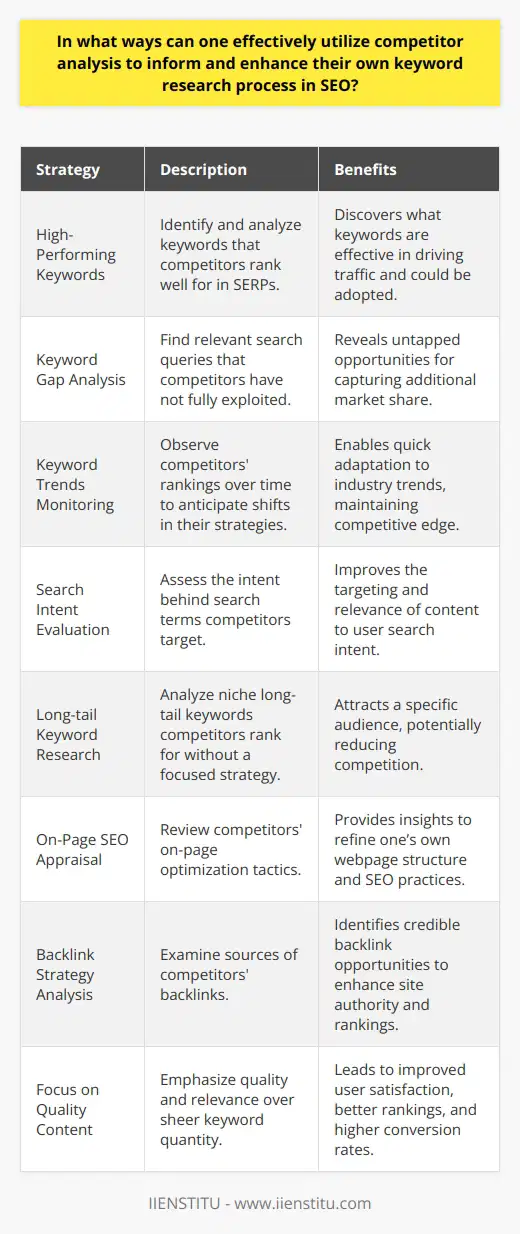
What are the key components of an effective keyword research process in SEO and how can these components be utilized to drive organic traffic and improve overall website visibility?
**Understanding the Basics of Keyword Research**
The key components of an effective keyword research process in SEO include understanding user intent, finding relevant search terms, analyzing competitiveness, and evaluating keyword performance. Comprehensive keyword research ensures that a website's content targets the appropriate audience, leading to increased organic traffic and improved overall visibility.
**User Intent and Relevant Search Terms**
Understanding user intent involves identifying the reasons behind users' search queries and aligning content accordingly. Marketers can analyze search engine data, user reviews, and consumer feedback to better comprehend the needs and preferences of their target audience. Finding relevant search terms requires utilizing tools such as Google Keyword Planner, SEMrush, and Ahrefs to discover high-volume, low-competition keywords that accurately represent users' queries. Incorporating these terms into website content increases the chances of ranking higher on search engine result pages (SERPs), thereby driving organic traffic.
**Competitiveness Analysis and Keyword Evaluation**
Analyzing the competitiveness of targeted keywords helps in determining the feasibility of outranking established websites in SERPs. Keyword competitiveness can be measured by both the search volume and the domain authority of the top-ranking websites. Low competition keywords with a high search volume are ideal for improving overall website visibility.
Evaluating keyword performance includes tracking website rankings, organic traffic, and user engagement. It is important to monitor these metrics regularly, making adjustments as necessary to maximize SEO outcomes. Google Analytics and other comprehensive SEO tools can be used to measure keyword performance and evaluate the overall success of a website's optimization strategy.
**Final Thoughts on Keyword Research in SEO**
In conclusion, an effective keyword research process for SEO encompasses comprehending user intent, finding relevant search terms, assessing competitiveness, and gauging keyword performance. Implementing these strategies can lead to a significant increase in organic traffic and improve a website's visibility in search engine results. Effective keyword research serves as the foundation of a successful SEO campaign, ensuring a website's content resonates with its intended audience.
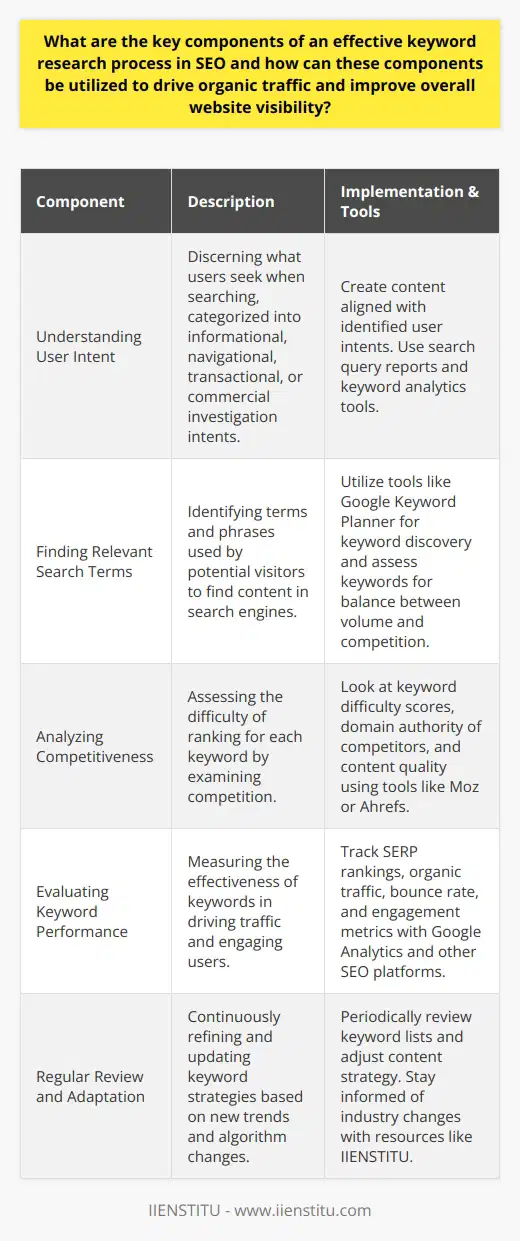
How can one integrate long-tail keyword research into a comprehensive SEO strategy to target specific niches and enhance on-page user experience?
Understanding Long-Tail Keyword Research
Incorporating long-tail keyword research into a comprehensive SEO (Search Engine Optimization) strategy is essential for successfully targeting specific niches and improving the on-page user experience. Long-tail keywords are longer, more specific search phrases that have lower search volumes than more general, or 'head,' keywords
Optimizing for Long-Tail Keywords
To integrate long-tail keyword research effectively, content creators must first identify relevant phrases by using keyword research tools like Google's Keyword Planner, Moz's Keyword Explorer, or SEMrush. These tools help find terms related to the primary keyword that have low competition, which makes ranking high in search engine results relatively easier. Additionally, analyzing competitors' websites can provide insight into their targeted terms and reveal potential long-tail keywords.
Addressing User Intent in Content
The next step entails creating valuable content by addressing the user intent behind the long-tail keywords. When users search for specific terms, they have precise expectations for the content they want to consume. By crafting content that fulfills these expectations, websites can attract their target audience, lower bounce rates, and increase the time users spend on the page. This improved user experience can also lead to better search engine ranking and conversions, making it crucial to consider the user's intent in content creation.
Incorporating Long-Tail Keywords Naturally
It is essential to incorporate long-tail keywords smoothly throughout the content without disrupting readability. Overusing keywords, a practice known as keyword stuffing, can harm SEO performance and negatively impact the user experience. Strategically placing these keywords within meta titles, descriptions, headings, image alt tags, and throughout the body of the content in a natural manner enhances SEO potential without detracting from the quality of writing.
Leveraging Internal and External Links
Lastly, linking to relevant internal and external webpages can further augment the effect of long-tail keyword optimization. By including internal links, content creators can direct users to other related pages on the website, showcasing expertise and promoting further exploration. Additionally, linking to reputable external sources not only provides users with valuable resources but also signals trustworthiness to search engines. This combined approach can improve the overall effectiveness of the SEO strategy and contribute to an enhanced user experience.
In conclusion, integrating long-tail keyword research into a comprehensive SEO strategy involves selecting relevant search terms, addressing user intent, incorporating keywords naturally within the content, and leveraging internal and external links. By focusing on these steps, content creators can effectively target niche audiences, improve the on-page user experience, and ultimately achieve better search engine rankings.
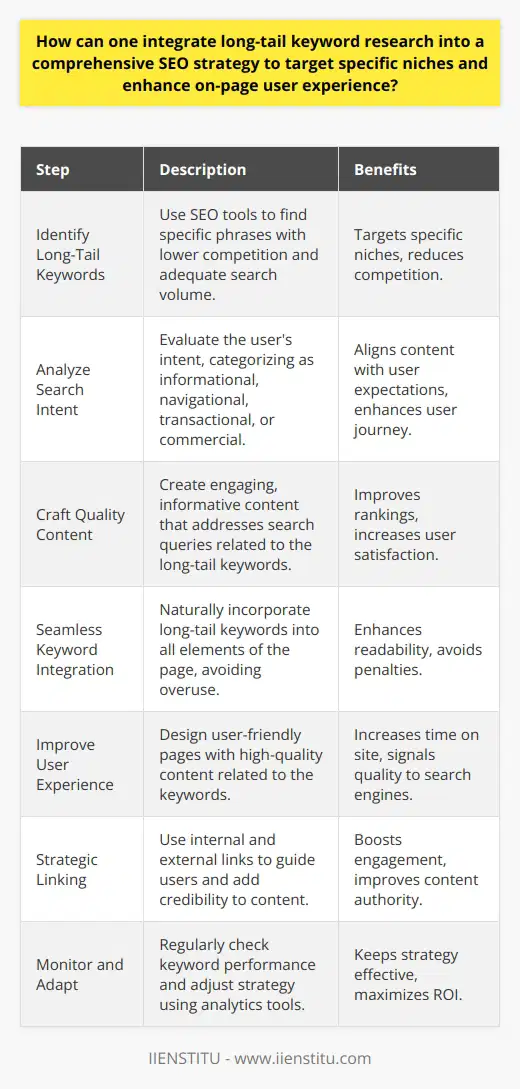
In what ways can competitor analysis and industry trends be incorporated into the keyword research process to maximize the effectiveness of an SEO campaign and maintain a competitive edge in the digital marketplace?
Integrating Competitor Analysis into Keyword Research
Competitor analysis is crucial for identifying the keywords that top-ranking websites in the industry are targeting. By examining the search data from these sites and identifying the commonly used terminology, businesses can generate a comprehensive list of industry-relevant keywords. Likewise, monitoring competitors' content gaps, backlink profiles, and on-page optimization techniques can reveal the untapped opportunities that need to be addressed to meet the demands of the niche audience.
Incorporating Industry Trends in Keyword Discovery
In addition to competitor analysis, understanding current industry trends is essential for SEO effectiveness. Businesses must familiarize themselves with the market trends and user preferences through continuous data monitoring and by actively engaging with the target audience on various platforms. Industry events, forums, and social media discussions are valuable sources of information regarding emerging keywords and varying user intent.
Leveraging Data for Optimized Content Creation
Once a robust set of keywords has been identified through competitor analysis and trend examination, businesses can create a content strategy tailored to these insights. Focusing on developing high-quality content that addresses user intent and incorporates industry-specific terminology can enhance organic visibility and boost search engine rankings. Furthermore, optimizing on-page elements such as meta tags, headers, and URL structures can improve the crawlability of a website, ensuring that content is properly indexed and ranked by search engines.
Maintaining a Competitive Edge through Continuous Monitoring and Adaptation
It is vital to continuously monitor the performance of the identified keywords, as search engine algorithms and user preferences change constantly. Using various SEO tools to track keyword rankings, website traffic, and user engagement can reveal which elements of the content strategy require modification. As competitors and industry trends evolve, regularly updating the keyword list, as well as refining content and optimization techniques, helps maintain a competitive edge in the digital marketplace.
In conclusion, the integration of competitor analysis and industry trends into the keyword research process significantly enhances the effectiveness of an SEO campaign. By identifying the terms that resonate with the target audience and optimizing content accordingly, businesses can achieve and maintain a competitive edge in the digital marketplace.
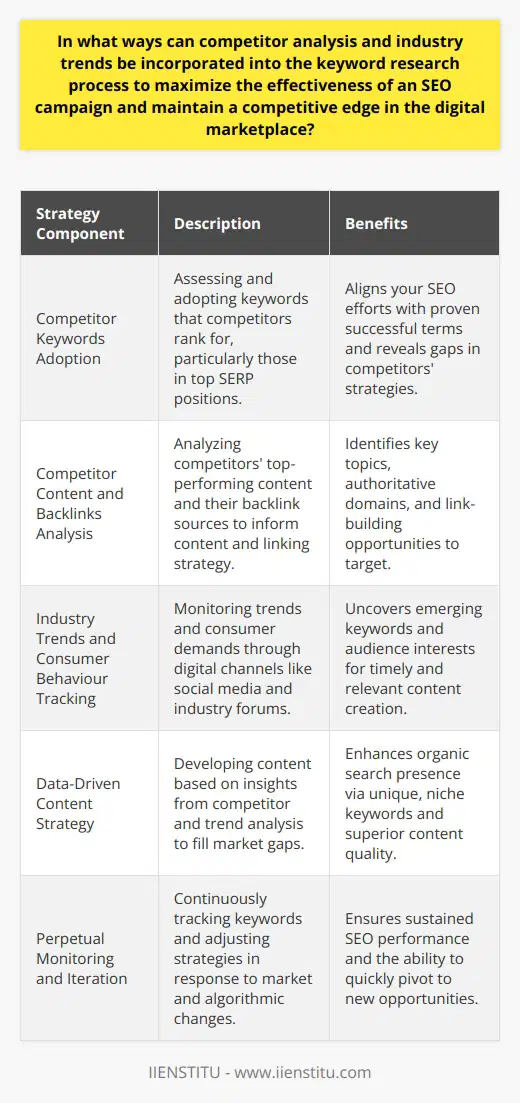
What are the essential components of a comprehensive keyword research strategy in SEO?
Essential Components of Keyword Research Strategy in SEO
Understanding Search Intent
A comprehensive keyword research strategy for search engine optimization (SEO) incorporates the understanding of user search intent. By analyzing the common queries and phrases used by target audiences, marketers can tailor content to address their needs and expectations effectively.
Selecting Relevant Keywords
Choosing the right keywords is crucial for driving organic traffic to a website. It is essential to create a list of short-tail and long-tail keywords that resonate with the target audience and accurately represent the content offered.
Evaluating Keyword Difficulty
An effective keyword research strategy involves assessing the competitiveness of keywords. By evaluating keyword difficulty, marketers can identify feasible ranking opportunities and focus their efforts on terms with lower competition that still provide a high potential for traffic generation.
Analyzing Search Volume
Examining the search volume of selected keywords allows for a deeper understanding of their potential to drive traffic. High search volume indicates a higher demand for information related to the keyword, whereas low search volume suggests a niche topic with limited scope for traffic growth.
Using Keyword Research Tools
Keyword research tools, such as Google Keyword Planner, Moz Keyword Explorer, and SEMrush, are indispensable for the success of targeted SEO efforts. These tools provide valuable insights into keyword metrics, such as search volume, keyword difficulty, and relevant long-tail alternatives.
Incorporating Long-Tail Keywords
Integrating long-tail keywords into content increases chances of ranking higher in search results, as they often face less competition compared to highly popular short-tail keywords. Moreover, long-tail keywords aid in targeting specific user queries and satisfying search intent more effectively.
Tracking Keyword Performance
Monitoring and tracking keyword performance is paramount to the success of SEO campaigns. Regular assessments of keyword rankings and performance metrics provide insights into the effectiveness of implemented strategies, thereby allowing marketers to make informed decisions for optimization.
In conclusion, a comprehensive keyword research strategy entails understanding search intent, selecting relevant keywords, evaluating keyword difficulty, analyzing search volume, using keyword research tools, incorporating long-tail keywords, and tracking keyword performance. By combining these elements, marketers can create SEO campaigns that drive organic traffic and improve website rankings, ensuring sustained online visibility and growth.

How do the different stages of SEO contribute to an effective online presence?
Stages of SEO and Online Presence
Understanding SEO Stages
Search Engine Optimization (SEO) is a crucial tool for establishing an effective online presence, and it generally occurs in three stages. The first stage, known as technical SEO, ensures that websites are structured effectively and use appropriate keywords, making them easy for search engines like Google to crawl and index. This is the foundation of SEO practice, and its implementation enhances a website's visibility and allows it to appear higher on search engine result pages (SERPs).
Creating Engaging Content
The second stage in the SEO process is on-page optimization, which refers to creating engaging, high-quality content that clearly communicates a website's expertise on a given topic. This content should be relevant, accessible, and useful to readers, which encourages them to share it and, in turn, helps improve the website's overall online presence. Additionally, intrinsic characteristics, such as well-researched keywords and appropriate meta-tags, are essential for enabling search engines to better understand the content, further facilitating its appearance on SERPs.
Promoting Content Effectively
Apart from technical and on-page optimization, SEO also encompasses off-page optimization, which is the third stage. This stage focuses on promoting the created content through various techniques, such as link building, social media marketing, and guest blogging. These methods aim to enhance the perceived value and trustworthiness of a website, thereby making it more attractive to users and search engines alike. The heightened reputation and increased visibility provided by off-page optimization are crucial in maintaining an effective online presence and encouraging user engagement.
In conclusion, the different stages of SEO work in tandem to contribute to an effective online presence. The seamless integration of technical, on-page, and off-page optimization allows websites to achieve better search engine rankings while also offering engaging and useful content to the users. Ultimately, a well-executed SEO strategy is vital for maintaining an authoritative and reputable online presence that can appeal to both human users and search engine algorithms.

In the context of SEO, what role does keyword research play in driving organic traffic to a website?
Keyword Research in SEO
Critical Foundation for Organic Traffic Generation
In the realm of search engine optimization (SEO), keyword research constitutes a vital element in enhancing organic traffic to a website, particularly for blog posts. This preliminary step involves identifying and analyzing specific words and phrases that users are likely to enter into search engines when seeking information about various topics. The primary objective of this process is optimizing content development and driving user engagement, thereby resulting in increased organic traffic.
Understanding User Intent and Industry Trends
Comprehending user intent behind search queries is crucial for crafting effective blog posts catered to audience interests. Keyword research facilitates this understanding, enabling content creators to produce targeted material aligned with consumer needs and preferences. Moreover, staying updated on evolving industry trends and dynamics via keyword research is instrumental in maintaining content relevance and attracting organic traffic.
Strategic Inclusion of Target Keywords
While creating blog posts, judicious inclusion of target keywords in various components, including titles, headings, meta descriptions, and content body, contributes to more effective SEO outcomes. Notably, striking an optimal balance between sufficient keyword density and natural language usage minimizes the risk of over-optimization, which can adversely impact search engine rankings and organic traffic.
Long-tail Keywords and Improved Content Discoverability
Employing long-tail keywords, which are longer and more specific phrases, offers a strategic advantage for driving organic traffic. Such keywords often have lower search volumes but face less competition, providing ample opportunities for niche websites and blogs to rank higher in search engine results. High-quality and relevant blog posts incorporating long-tail keywords serve to improve content discoverability, increase visibility, and subsequently, foster growth in organic traffic.
In conclusion, keyword research plays an indispensable role in driving organic traffic to a website, particularly blog posts. Through effectively understanding user intent, capitalizing on industry trends, and integrating target keywords thoughtfully, content creators can enhance the visibility and discoverability of their material. By leveraging the benefits of long-tail keywords, they can further optimize their SEO tactics in favor of more sustainable and robust organic traffic generation.

What are the six phases of SEO and how do they contribute to a comprehensive digital marketing strategy?
Phases of SEO in Digital Marketing Strategy
Keyword Research and Analysis
The first phase involves identifying and analyzing keywords relevant to a brand's target audience. These keywords are central components of search engine optimization, aiding in improving website visibility and traffic. Using tools like Google Keyword Planner, businesses can pinpoint high-volume, low-competition phrases for their content.
Website Optimization
Optimizing website structure and content elements marks the second phase. It involves improving webpage load times, user experience, and mobile-friendliness. Site factors, such as meta tags, headings, and image optimization, drive search engine ranking and, consequently, attract more online visitors.
Content Creation and Curation
Developing valuable, informative, and engaging content is critical in the third phase. This involves generating various content types, including blog posts, infographics, and videos, rich in targeted keywords. High-quality content builds brand credibility, fosters customer trust, and attracts backlinks – essential factors for improving search engine performance.
Link Building
The fourth phase emphasizes receiving backlinks from credible and authoritative websites. These backlinks signal search engines that a site provides trustworthy information, bolstering website rankings. Tactics include guest blogging, social media marketing, and public relations efforts to build a robust network of backlinks.
Technical SEO
The fifth phase involves ensuring website functionality, including indexing, crawling, and rendering. Technical SEO actions aim to optimize a website's infrastructure, making it easy for search engines to understand and rank content. This includes refining the site map, applying canonical tags, and addressing duplicate content issues.
Monitoring and Reporting
Lastly, continuous monitoring and evaluation of SEO performance allows for data-driven decisions and adjustments. Google Analytics and Google Search Console provide valuable insights into user behavior, traffic sources, and content engagement. This final phase helps businesses refine their digital marketing strategies to achieve sustained growth and a competitive advantage.
In conclusion, understanding and implementing the six phases of SEO is integral to a comprehensive digital marketing strategy. By prioritizing keyword research, website optimization, content creation, link building, technical SEO, and ongoing monitoring, businesses can streamline their online presence and improve search engine performance – both essential for driving digital growth.

What key factors should be considered during the keyword research process to ensure an effective SEO plan?
Understanding the Target Audience
The first essential factor in the keyword research process is understanding the target audience. Comprehending their needs, interests, and preferences will allow for the identification of relevant keywords that effectively resonate with the target group. This understanding should include demographics, psychographics, and behavioral patterns, as these factors will significantly influence their search queries and terms.
Analyzing Competitors' Strategies
Another vital aspect to consider is the analysis of competitors' keyword strategies. Examining the competition’s keyword usage enables the identification of potential opportunities to outrank them in search engine results. This process involves exploring competitors' high-performing keywords, determining any gaps or niches in the keyword market, and synthesizing this information into a cohesive SEO plan tailored for the specific industry or niche.
Long-tail Keywords
Long-tail keywords, typically phrases of three or more words, are an essential factor in keyword research. As these types of keywords are more specific and cater to a smaller audience, they are often linked with higher conversion rates and reduced competition. Utilizing long-tail keywords in the SEO strategy helps in targeting more focused groups of potential customers, thus increasing the odds of successful conversions.
Keyword Relevance and Intent
In addition to selecting popular keywords, it is important to consider their relevance and search intent. A useful keyword should not only meet the search volume criteria but also align with the content and goals of the site. Focusing on keywords that genuinely match the intent of the target audience ensures the effective reach of potential customers and improves overall site usability.
Local SEO and Mobile Optimization
Considering local SEO and mobile optimization during keyword research is also imperative for a successful SEO plan. Local search optimization involves targeting location-based keywords to attract nearby customers. Simultaneously, mobile optimization ensures that the website is accessible and easy to navigate on various mobile devices. Incorporating both elements into the keyword research process increases the likelihood of attracting a diverse audience and enhancing user experience.
In conclusion, a comprehensive keyword research process should consider the target audience, competitors' strategies, long-tail keywords, keyword relevance and intent, and local SEO and mobile optimization. By carefully examining these factors, an effective SEO plan can be developed, leading to improved search engine rankings and increased website traffic.

How does understanding the different phases of keyword research help in optimizing a website's organic search performance?
Significance of Keyword Research Phases
Understanding the different phases of keyword research plays a crucial role in optimizing a website's organic search performance. By comprehending each phase properly, one can derive extensive benefits in terms of search engine ranking, user engagement, and overall website visibility.
Identifying Target Keywords
The first step in keyword research involves identifying target keywords relevant to the website's theme and potential audience. This process helps in generating a curated list of terms that users are likely to search for when looking for information related to the site's niche market. By selecting the most appropriate keywords, the website can establish a strong foundation for successful organic performances.
Analyzing Keyword Competitiveness
Once the target keywords are recognized, it is essential to analyze their competitiveness in the digital space. This evaluation enables website owners to identify high-performing keywords with lower competition rates, thereby allowing the website to rank higher in search results. A thorough examination of keyword competitiveness contributes significantly to boosting a site's organic search performance.
Refining Keyword List
After gauging keyword competitiveness, the website owner can refine the initial list, focusing on the most effective keywords. This process ensures that the chosen keywords align with the site's objectives and accurately represent the intended content. As a result, this selective approach enhances the site's relevance to both users and search engine algorithms, optimizing its organic search performance further.
Mapping Keywords to Content
To truly capitalize on keyword research, it is vital to map selected keywords to relevant content on the website. This strategic planning assists in building a cohesive site structure, with each web page optimized for specific keywords and themes. Consequently, this organized content architecture enhances the website's overall user experience and improves organic search visibility.
Monitoring and Updating Keywords
Finally, continuous monitoring and updating of keywords prove indispensable in maintaining optimal organic search performance. Regular evaluation of keyword effectiveness ensures that the website remains current and relevant, adapting to changing user preferences and search engine trends.
In conclusion, a comprehensive understanding of the different phases of keyword research significantly contributes to optimizing a website's organic search performance. From selecting relevant keywords to monitoring their effectiveness, each phase plays a vital role in enhancing a site's search ranking, user engagement, and overall visibility.

What are the fundamental principles underlying a successful keyword research process in SEO?
Understanding Fundamentals of Keyword Research
The fundamental principles underlying a successful keyword research process in SEO involve understanding search intent, analyzing search volume, and discovering relevant long-tail keywords.
Recognizing Search Intent
To begin with, comprehending search intent is crucial for selecting targeted keywords that align with users' objectives. Search intent involves four types: informational, navigational, transactional, and commercial investigation. Identifying the intent behind a specific query allows marketers to create content that fulfills users' needs, driving organic traffic and improving search rankings.
Evaluating Search Volume
Another crucial aspect of keyword research is analyzing search volume, which refers to the number of times a particular keyword is searched within a specific timeframe. Accurate search volume data help marketers to identify relevant, high-traffic keywords, ensuring optimum visibility for the webpage. However, it is important to balance search volume with keyword difficulty, as high-volume keywords may be highly competitive. To strike the right balance, experts recommend focusing on medium-volume keywords with low competition.
Discovering Long-tail Keywords
To maximally benefit from SEO efforts, discovering long-tail keywords is essential. Long-tail keywords are longer, more specific phrases that users search when they are closer to fulfilling their search intent. These keywords usually have less competition and drive more targeted traffic, offering higher conversion rates. By strategically incorporating long-tail keywords into the content, a website can rank better for multiple search queries, resulting in an increase in organic traffic and overall visibility.
Utilizing Keyword Research Tools
Successful keyword research requires leveraging various SEO tools that can assist in identifying lucrative keywords. Tools like Google Keyword Planner, Moz's Keyword Explorer, and SEMrush provide valuable insights into search volume, competition, and related keyword suggestions. These tools help marketers discover high-potential keywords and better understand search trends, enabling them to craft optimized content that resonates with their target audience.
Conclusion
In conclusion, a successful keyword research process lies in understanding search intent, analyzing search volume, discovering long-tail keywords, and leveraging SEO tools. By embracing these fundamental principles, marketers can create targeted, relevant content that caters to users' needs, improving organic search rankings and website visibility.

How does the keyword research phase play a crucial role in the overall SEO strategy of a website?
Significance of Keyword Research in SEO Strategy
Identifying Targeted Keywords
The keyword research phase is a vital component of the overall search engine optimization (SEO) strategy of a website as it primarily focuses on identifying the relevant keywords that the target audience frequently uses. By determining the right keywords, website owners can develop content that addresses the needs and queries of their potential users, resulting in higher search engine rankings and increased website traffic.
Improving On-Page Optimization
Proper keyword research assists in enhancing the website's on-page optimization, which contributes to better search engine ranking. The implementation of targeted keywords in crucial areas such as the title tag, meta description, headings, and throughout the content amplifies the website's relevance for search engine algorithms. Consequently, the website gains increased visibility and attracts organic traffic from users searching for the identified keywords.
Analyzing Competitors' Strategies
An effective keyword research process examines the keywords utilized by competitors, providing valuable insights into their SEO strategies. By comprehending the competition's focus areas, website owners can adapt and refine their content, differentiating their site from others in the industry. Identifying gaps in competitors' keyword strategies also allows for the creation of unique content that can cater to users' unmet needs, further bolstering the site's overall SEO strategy.
Guiding Content Development
Keyword research offers guidance for content development and sets the foundation for generating blog posts and web pages that resonate with the target audience. Since it highlights the popular search terms and phrases, content creators can tailor their work to address the primary concerns and interests of their users. This approach not only improves the website's SEO performance but also establishes the site as a valuable information source, leading to increased user engagement and repeat visits.
In conclusion, the keyword research phase is indispensable for designing an effective SEO strategy that ensures optimal website performance. By identifying targeted keywords, improving on-page optimization, analyzing competitors' approaches, and guiding the development of engaging content, website owners can strengthen their online presence, rising through search results and reaching their desired audience.

Can you elaborate on the significance of long-tail keywords and their impact on both SEO and user experience?
**The Importance of Long-Tail Keywords**
Long-tail keywords play a crucial role in enhancing search engine optimization (SEO) and user experience. Essentially, these keywords are more specific, containing three or more words, and they enable websites to target niche demographics. As a result, the role of long-tail keywords is highly significant in shaping both the SEO landscape and the general user experience.
**Impact on Search Engine Optimization**
In the context of SEO, long-tail keywords are advantageous, primarily because they face less competition, enabling websites to rank higher. With lower search volumes, these keywords demonstrate improved conversion rates, attracting audiences that have a clearer intention to purchase or access specific information. Consequently, focusing on long-tail keywords helps to facilitate better organic search rankings, inviting more traffic to a website.
**Enhancing User Experience**
Along with impacting SEO, long-tail keywords contribute to creating a better user experience. Due to their specificity, long-tail keywords help ensure that the content presented is more relevant to users' search queries. By providing the information users are seeking, websites can significantly improve user satisfaction, which can lead to increased time spent on the site, a reduction of bounce rates, and ultimately foster a sense of loyalty toward the website.
**Optimization Strategies**
To capitalize on the benefits of long-tail keywords, it is imperative to conduct thorough keyword research, employing tools like Google Keyword Planner to identify phrases that have potential to rank well. Additionally, creating high-quality, relevant content centered around these keywords will further strengthen the website's ranking capacity and improve the overall user experience.
**Conclusion**
In summary, long-tail keywords greatly influence SEO and user experience in various ways. They enable websites to rank higher by targeting niche markets, they improve conversion rates, and they contribute to a more satisfying user experience by offering relevant content. By incorporating long-tail keywords into content creation and utilizing smart optimization strategies, businesses and website owners can witness substantial improvements in their online presence and visitor satisfaction levels.



